
 |
Philatelic History of Wilmington, North CarolinaRevised 11/26/2023 |
| (> 1859) Page 1 | (1860-1897) Page 2 | (1898-1916) Page 3 | (1917-1941) Page 4 | (1942-1971) Page 5 | (1972 >) Page 6 |
Philatelic Item |
It is our hope that this web-page will serve to stimulate an interest in the collecting, conservation and documentation of postal history covers of Wilmington.
Wilmington Philatelic Society |
|||
|---|---|---|---|---|
| Year | Pix | Cat # | Description | By |
|
World War One (the Great War 1914-1918) and by its end on November 11, 1918, nine million people had died on the battlefield. Factories and mills dotted the Cape Fear River. Shipyards gained new prominence as the war required more supply and troop ships than ever before. Wilmington prospered as a major port and ship-building center. The Atlantic Coast Line offered 26 passenger trains daily connecting Wilmington to Washington DC. Wilmington boasted one of the finest bathing and fishing resorts along the US Atlantic coast.
|
||||
| 1917 |
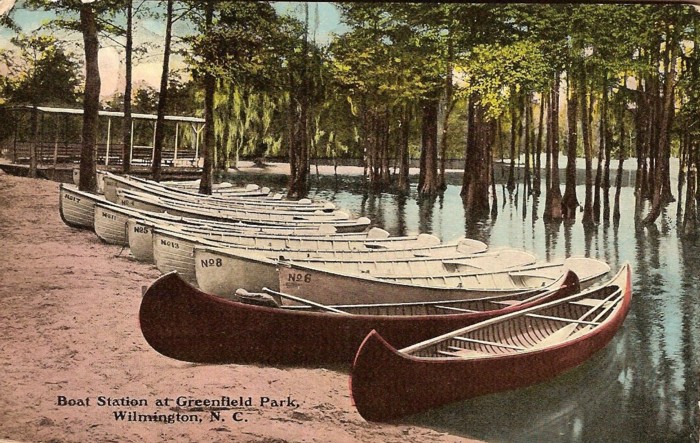
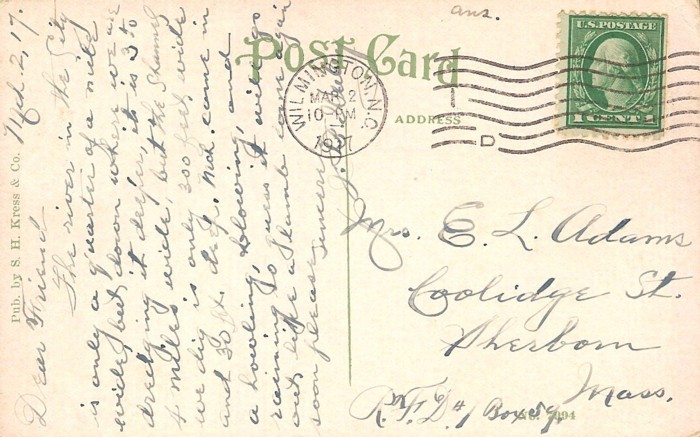
|
424 | A post card cancelled on March 2, 1917 and sent to Sherborn MA. It shows Greenfield Lake in Wilmington NC. |
JJ |
| 1919 |
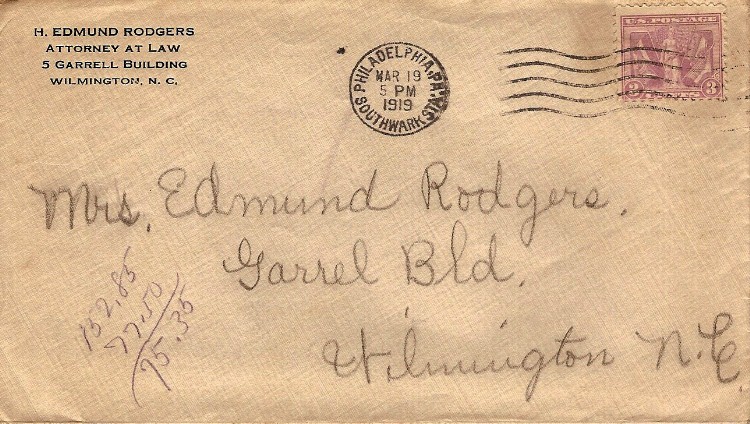
|
537 | A cover canceled on March 19, 1919 at Philadelphia PA and sent to Wilmington NC. History: See above cover - 1916 |
LS |
| 1922 |
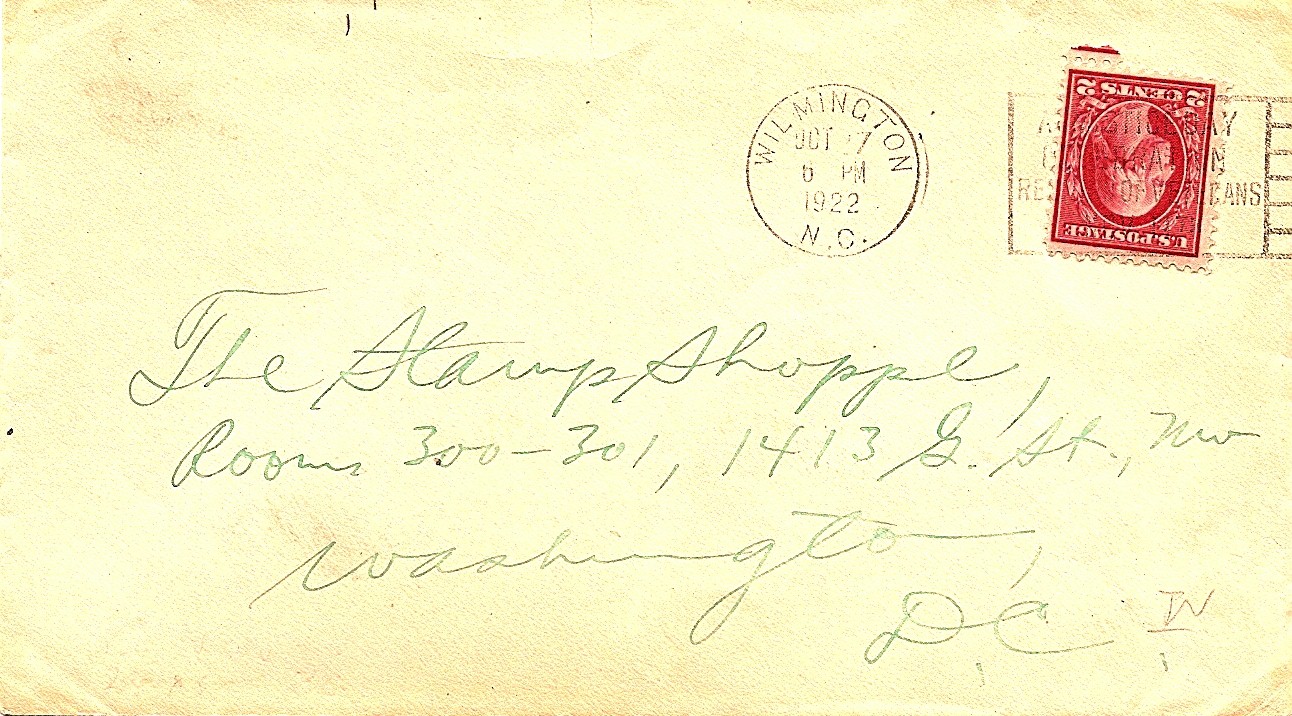
|
528 | A cover sent on October 27, 1922 from Wilmington to Washington DC. The US Post Office uses cancels to commemorate important events. The stamp on this cover was canceled commemorating Armistice Day (the end of WW-I).
History: Armistice Day is the anniversary of the symbolic end of WW-I on November 11, 1918. It commemorates the armistice signed between the Allies and Germany at Compiègne France, for the cessation of hostilities on the Western Front, which took effect at eleven o'clock in the morning - the "eleventh hour of the eleventh day of the eleventh month." The date was a national holiday in many of the former allied nations to allow people to commemorate those members of the armed forces who were killed during war. After WW-II, it was changed to Veterans Day in the United States and to Remembrance Day in the British Commonwealth of Nations. Armistice Day is an official holiday in France. It is also an official holiday in Belgium, known also as the day of peace in the Flanders Fields. |
GS |
| 1923 |
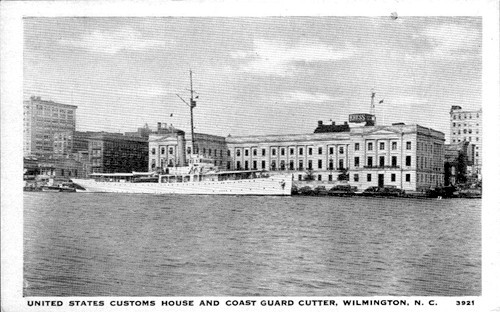
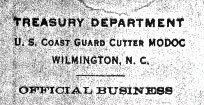
|
--- | A post card (circa 1923) showing the "Cutter Modoc" docked in front of the Wilmington NC "Customs House/United States Courthouse." Below it is a "return address" from Modoc official mail. History: The USCGC Modoc was a “Tampa Class” multi-role US Coast Guard cutter built by Union Construction of Oakland California in 1922. She was commissioned on January 14, 1923 and was suitable for coastal patrols, search and rescue and ice patrols. In 1923 the Modoc was assigned to its first duty station, home-ported in Wilmington NC. Modoc undertook rotational 15-day Atlantic ice patrol service with the International Ice Patrol off the Grand Banks for nearly 18 years until the outbreak of WW-II. She was transferred to the US Navy on November 1, 1941 with orders to join the Greenland Patrol keeping convoy routes open, breaking and finding leads in ice for the Greenland convoys, escorting the convoys and rescuing survivors from torpedoed ships, constructing and maintaining aids to navigation and reporting weather conditions. After Pearl Harbor, she was fitted with additional anti-aircraft guns as well as depth charges, sonar and radar. Her operational duties included convoy escort, the search and rescue of sailors from torpedoed ships, logistics as well as search and destroy missions. She received one battle star for her service during WW-II. The Modoc was returned to the Treasury Department in December 1945 and served as a patrol cutter. In 1947 the Modoc and her sister ships where decommissioned. She was sold to Manuel Velliantis of Honduras and renamed Amalia V. In 1960 she was sold to Tropical Navigation and renamed Machala. She was scrapped in 1964. |
JJ |
| 1923 |
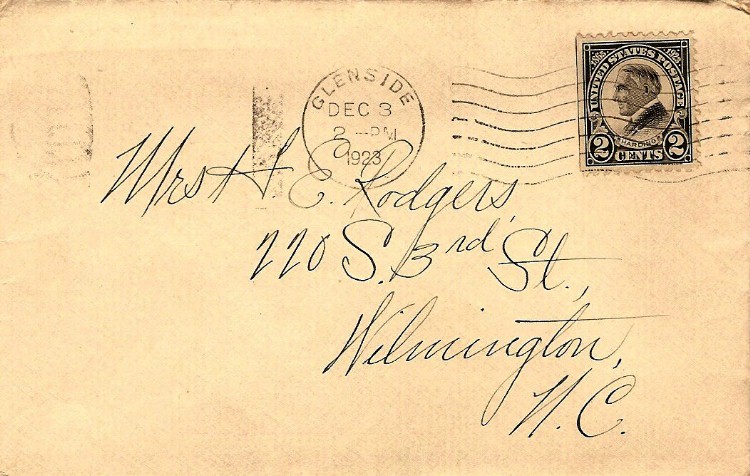
|
610 | A cover canceled on December 3, 1923 at Glenside PA and sent to Wilmington NC. History: See above cover - 1916 |
LS |
| 1924 |
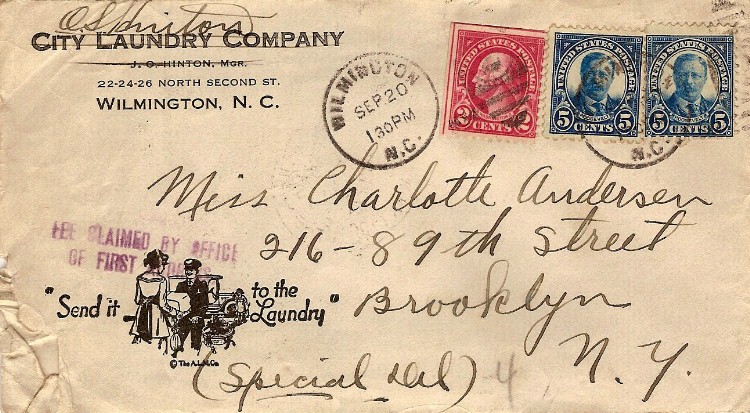
|
2x557 554 |
A cover canceled on September 20, 1924 at Wilmington NC
and sent to Brooklyn NY. This cover with its special cachet
was sent by OS Hinton of the City Laundry Company (North Second Street, Wilmington). History: The Hinton family had roots in the history of Wilmington NC. They owned interest in the Seashore Hotel, the Orton Hotel and the City Laundry Company on North Second Street. The City Laundry Company provided laundry services for commercial and residential customers in Wilmington. Edgar Latimer Hinton (3/26/1919 ~ 10/12/1958) left Wilmington for an acting career in Los Angeles CA where sons, Darby and Daryn and daughter, Darcy were born. Darby Hinton made his acting debut at the age of 6 months going on to appear as a child actor in commercials, films and tv series. He played Israel, the son of Daniel Boone on the classic 1960's television series starring Fess Parker. |
LS |
| 1924 |
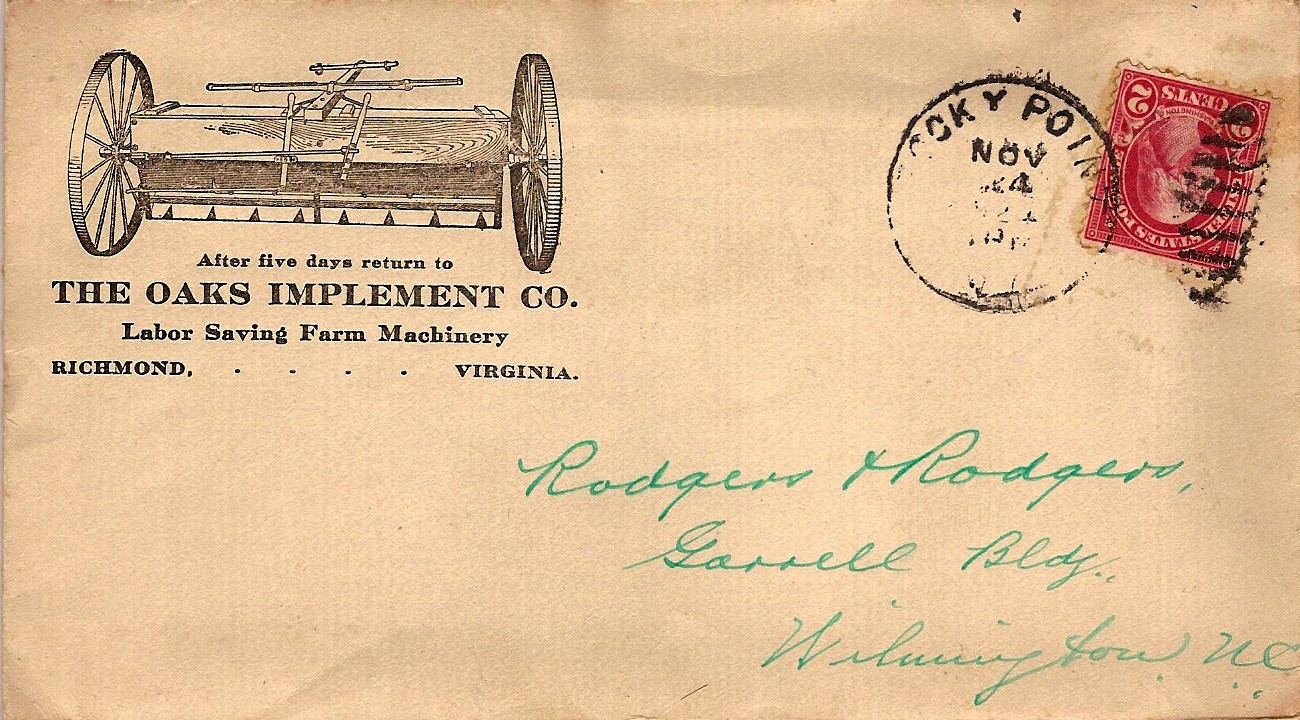
|
554 | A cover canceled on November 22, 1924 at Rocky Mount NC and sent to Rodgers and Rodgers Law Firm in Wilmington NC. History: See above cover - 1916 |
LS |
| 1926 |
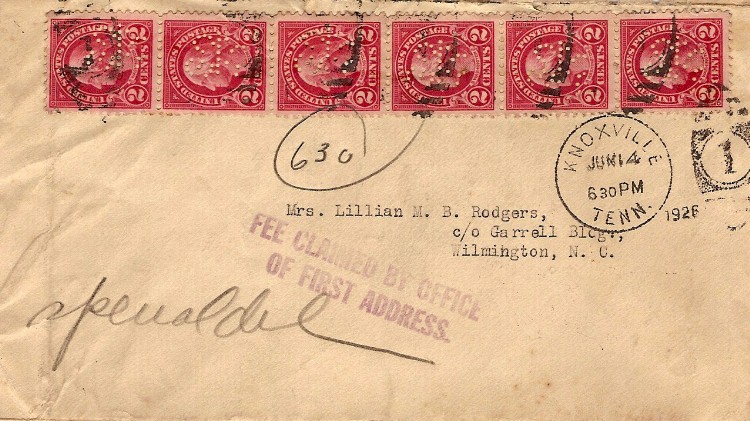
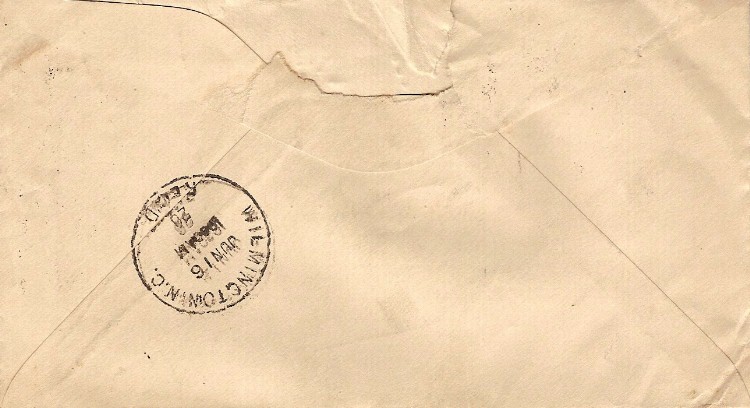
|
6x554 | A cover canceled on June 14, 1926 at Knoxville TN and sent to Wilmington NC. It was sent via special delivery to Lillian Rodgers, wife of H Edmund Rogers, Attorney at Law in Wilmington. History: See above cover - 1916 |
LS |
| 1929 |
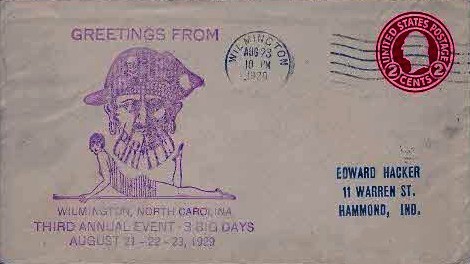
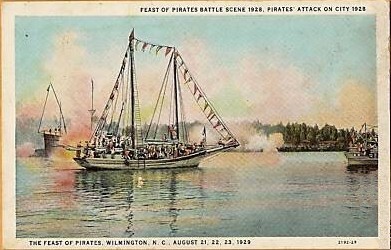
|
U-429 | A cover canceled on August 23, 1929 at Wilmington NC
commemorating the "Feast of Pirates." Below it is a post card showing a mock pirate attack on the city of
Wilmington History: The Feast of Pirates was an annual festival held in Wilmington NC between 1927 and 1929 over a weekend in the month of August. For several days Wilmington embraced this celebration of merriment with a parade, pirate boats on the Cape Fear River and other events all centered around the theme of pirates and rogues that flourished in the sounds, inlets and rivers of North Carolina's Atlantic coast. In the late 17th and early 18th century numerous pirates pursued their lawless and murderous trade preying upon lightly armed merchant ships delivering goods to coastal cities. Blackbeard was the most notorious pirate in the history of seafaring. With a beard that almost covered his face, he would strike terror into the hearts of his victims. He was a tall man with a menacing appearance who usually wore a crimson coat, two swords at his waist and bandoleers stuffed with numerous pistols and knives across his chest. The sight of Blackbeard was enough to make most of his victims surrender without a fight. His lawless career lasted only a few years but his fearsome reputation has long outlived him. Governor Alexander Spotswood of Virginia sent a Royal Navy contingent to North Carolina where Blackbeard was killed in a bloody battle at Ocracoke Inlet NC on November 22, 1718. Blackbeard had captured over 50 ships during his piratical career and his death ended an era in the history of piracy in America. |
OO |
| 1930 |
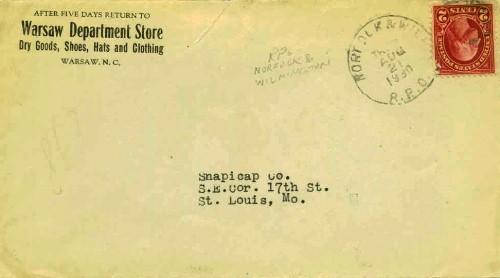
|
634 | A Railway Post Office cover canceled on August 21, 1930 while on the Norfolk-Wilmington railroad and sent to Saint Louis MO.
History: New Hanover County was served by several railroads including the Seaboard Air Line, the Atlantic Coast Line, and the Wilmington, Brunswick & Southport Railways. The Atlantic Coast Line moved its headquarters from Wilmington NC to Jacksonville FL in 1961. ACL merged with Seaboard Air Line Railways in 1967 to form the Seaboard Coast Line. The Norfolk-Wilmington branch of the Atlantic Coast Line connected with the main railroad line at Rocky Mount NC (Washington DC to Tampa FL). The Norfolk-Wilmington provided passenger service and also utilized special railroad cars that were staffed by Railway Mail Service postal clerks who would sort mail en route in order to speed mail delivery. The postal mail canceled on these railroad cars received special RPO (Railway Post Office) postmarks. Visit the Wilmington Railroad Museum. |
TB |
| 1930 |
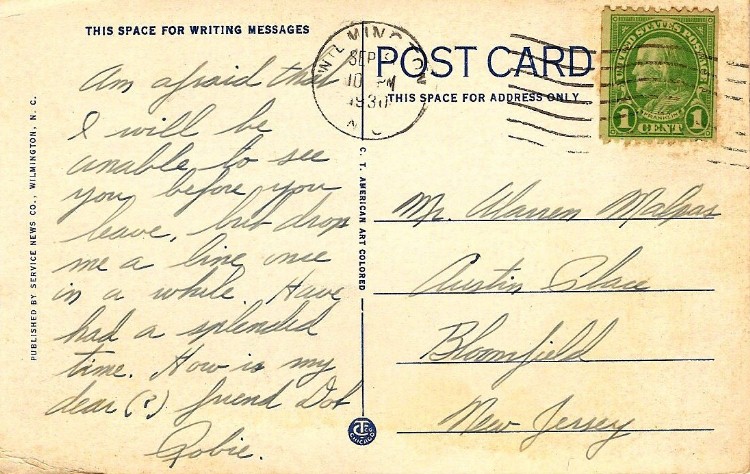
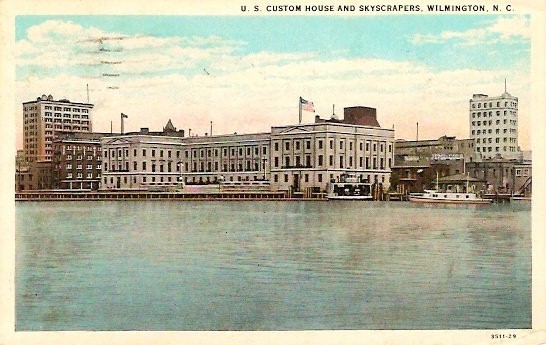
|
604 | A post card of the Custom's House and Market Street
Ferry (crossing the Cape Fear River) canceled on September 1, 1930 at Wilmington NC. History: Market Street was the most heavily traversed road in Wilmington NC. Before the American Revolution, Market Street was part of the "King's Highway," a major route from the northern colonies to points in the south, such as Charleston. The route crossed the Cape Fear River via the Market Street Ferry that was located at the foot of Market Street along the river's edge. In the 1920's ferries, John Knox and Menantic were in constant service providing transport across the river. The ferries operated until 1935 when they were considered obsolete after the construction of a river-spanning bridge. Market Street was also known as the "Road to New Bern" serving as the route from the colonial port and business center of Wilmington. This rich history of trade and commerce continues today as Market Street still constitutes one of the largest commercial corridors in New Hanover County. |
JJ |
| 1930 |
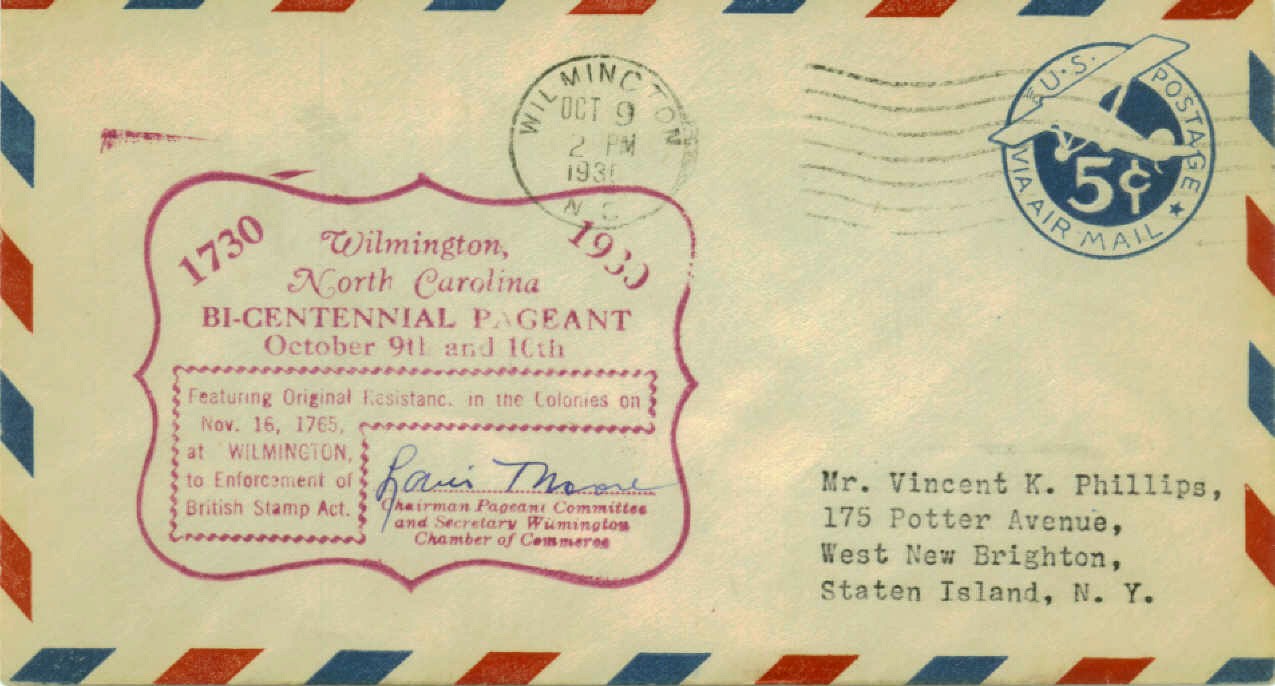
|
UC-1 | An airmail cover sent on October 9, 1930 to Vincent Phillips in Staten Island NY. The cover commemorates the Bi-Centennial of Wilmington and is signed by Louis Moore, Secretary of the Wilmington Chamber of Commerce. The cachet mentions Wilmington's resistance to the enforcement of the British Stamp Act of November 16, 1765. | RP |
| 1930 |
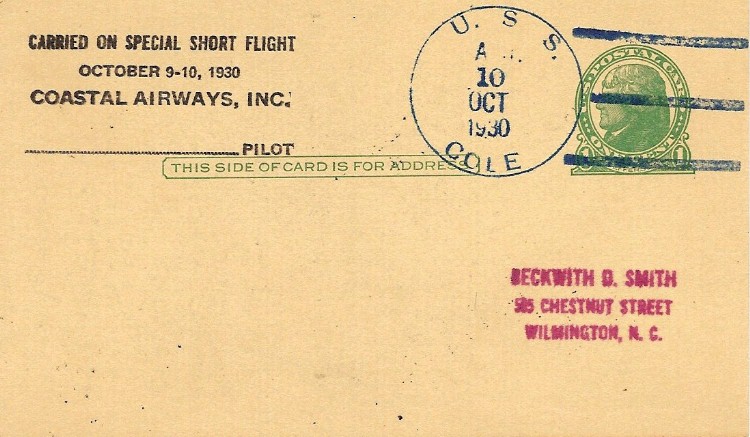
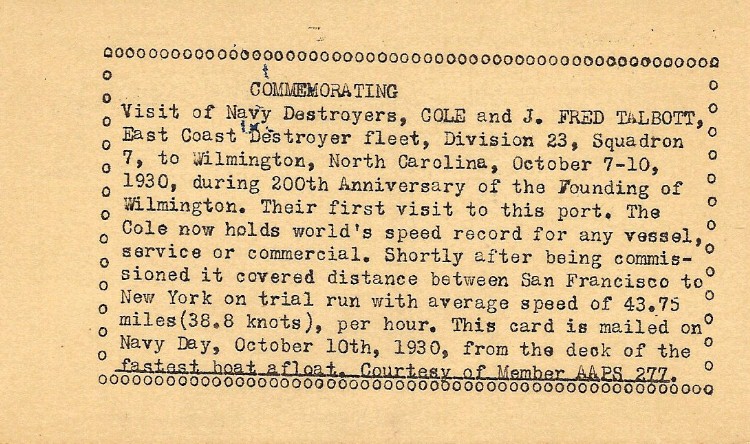
|
UX-27 | A postal card canceled on October 10, 1930 on the deck of the USS Cole posted to Wilmington NC. The USS Cole (DD-155) and the USS J Fred Talbott (DD-156) visited Wilmington during its Bi-Centennial (200th) celebration. History: Warren Kinchen Pennington was born on March 16, 1899. His good friend, Kenyon Woody had made a grass air-strip adjacent to the Wrightsville Trolly tracks between Floral Parkway and Audubon to use with his military-surplus Jenny aircraft. Pennington soloed in Kenyon's Jenny aircraft in 1919 and during the 1920s made a young man's living barnstorming around the east coast. In 1929 Pennington became chief pilot and manager of Coastal Plains Airways which had been formed by a group of businessmen from Rocky Mount NC. On October 9/10, 1930 Wilmington celebrated the 200th birthday of its founding. This Wilmington Bi-Centennial celebration pageant was high-lighted by the visit of two US Naval destroyers (the USS Cole and the USS J Fred Talbott) to the shores of Wilmington. As part of the Wilmington celebration, commemorative mail that was cancelled on the deck of the Cole was brought to the Wilmington Airport. Warren Pennington carried a small pouch of mail on October 9, 1930 on a special short flight from the airport circling over the Cole returning to the airport where it was delivered to the Wilmington main post office for further dispatch through the mails. The next day on October 10, 1930 additional mail was canceled on the deck of the Cole before entering the postal system. Pennington’s Coastal Plains Airways went on to provide the first passenger service at Wilmington's Bluethenthal Airfield. |
JJ |
| 1931 |
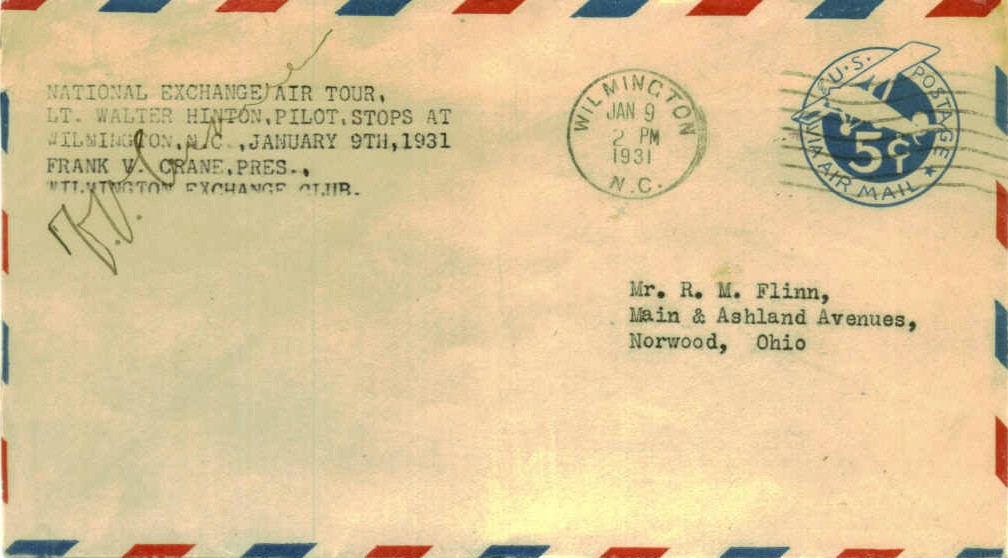
|
UC-1 | An airmail cover sent on January 9, 1931 by Frank V Crane from Wilmington to Norwood OH. The cover commemorates the visit of Lieutenant Walter Hinton to Wilmington. LT Hinton piloted the first aircraft flight across the Atlantic Ocean. The National Exchange Club sponsored Hinton in its US “Service to Aviation” Air Tour. The cover is signed by Frank V Crane, President of Wilmington's Exchange Club.
History: The National Exchange Club was formed in Detroit MI in 1911. It quickly evolved into groups of men and women working together to make US communities better places to live through programs of service in Americanism, community service, youth activities and its national project, the prevention of child abuse. The Exchange Club provided its members with opportunities to serve their communities, develop leadership skills and interact with other like-minded business and professional persons. It is made up of approximately 1,000 clubs across cities in the United States and Puerto Rico under its motto, “Unity for Service.” In 1927 the Wilmington Exchange Club along with county commissioners were enthusiastic about developing “River Road,” a scenic route following the banks of the Cape Fear River. It was envisioned to extend from Wilmington’s shipyard to the inland waterway bridge over Snow’s Cut. This scenic roadway was finally completed in 1946. Americanism and progress in aviation prompted the National Exchange Club to sponsor the Women's Air Derby as part of the 1929 National Air Races and Aeronautical Exposition in Cleveland OH. Later in 1931 the National Exchange Club sponsored Lieutenant Walter Hinton in its “Service to Aviation” Air Tour to selected cities in the US. The NC-4 aircraft, commanded by Lieutenant Commander AC Read and piloted by Lieutenant Walter Hinton was the first aircraft to fly cross the Atlantic Ocean in May 1919. The Wilmington Exchange Club under its president, Frank V Crane hosted Lt Hinton on his visit to Wilmington in January 1931. |
RP |
| 1931 |
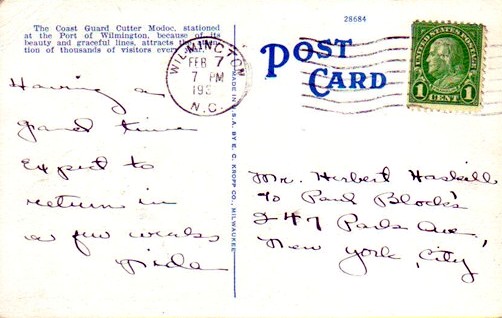
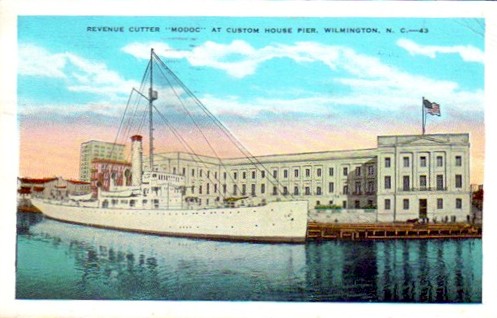
|
632 | A post card canceled in Wilmington NC on February 7, 1931 showing the "Cutter Modoc" docked in front of the Wilmington NC "Customs House/United States Courthouse." History: See above post card - 1923 |
JJ |
| 1931 |
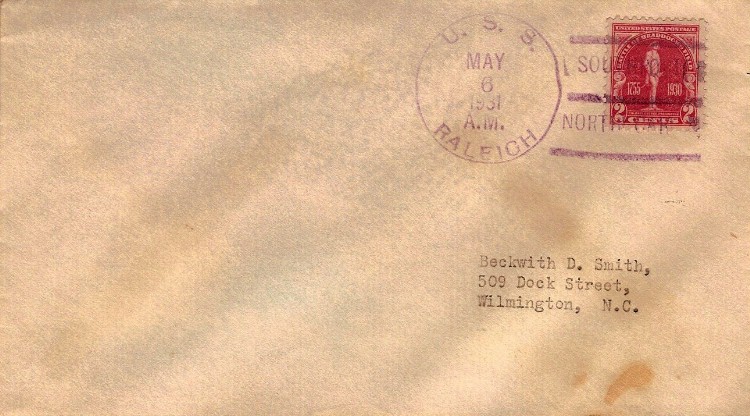
|
688 | A cover canceled on May 6, 1931 from the USS Raleigh (in Southport NC) and sent to Wilmington NC. History: The USS Raleigh was a 7,050-ton Omaha class light cruiser built in Quincy MA. She was commissioned in February 1924 and made a maiden cruise to northern Europe. After four years of operations with the Scouting Fleet in the Atlantic, Pacific and Caribbean, the Raleigh returned to European waters in September 1928 for a year-long tour as the US Navy's flagship. In late 1929 the Raleigh returned to the Scouting Fleet in the Atlantic before shifting to San Diego CA in 1933. Between 1936-38 the Raleigh was the flagship of Squadron 40-T which operated off Spain during Spain's bloody civil war. She spent the late 1930s and the early 1940s in the Hawaiian area taking an active part in the US Fleet's exercises. On December 7, 1941 the Raleigh was moored at Pearl Harbor when the Japanese Navy made their raid. She was badly damaged by a torpedo and near-missed by a aerial bomb. After repairs at Pearl Harbor and Mare Island Navy Yards, the Raleigh was again ready for service in mid-1942. The Raleigh operated in the south and central Pacific for the rest of 1942 and then reassigned to the Aleutians until June 1945. Her activities included convoy escort, patrols in contested waters and bombardment of Japanese-held islands. She was sent back to the Atlantic during the summer of 1945 and was briefly used to train Naval Academy midshipmen. She was decommissioned in November 1945 and sold for scrap in February 1946. |
JJ |
| 1931 |
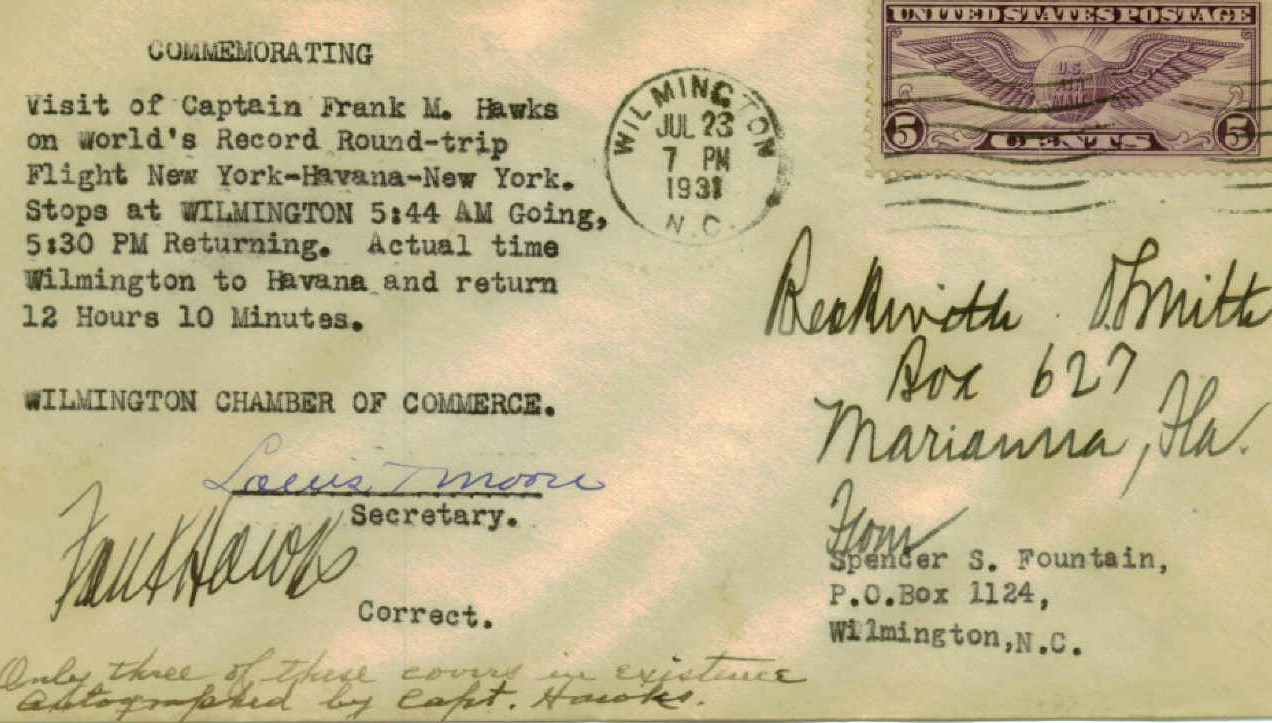
|
C-12 | An airmail cover sent on July 23, 1931 by Spencer S Fountain of Wilmington to Marianna FL. The cover commemorates the visit of Captain Frank Hawks to Wilmington on his record round-trip flight between New York-Havana Cuba-New York. The cover is signed by Louis Moore, Secretary of the Wilmington Chamber of Commerce and by Captain Hawks. | RP |
| 1931 |
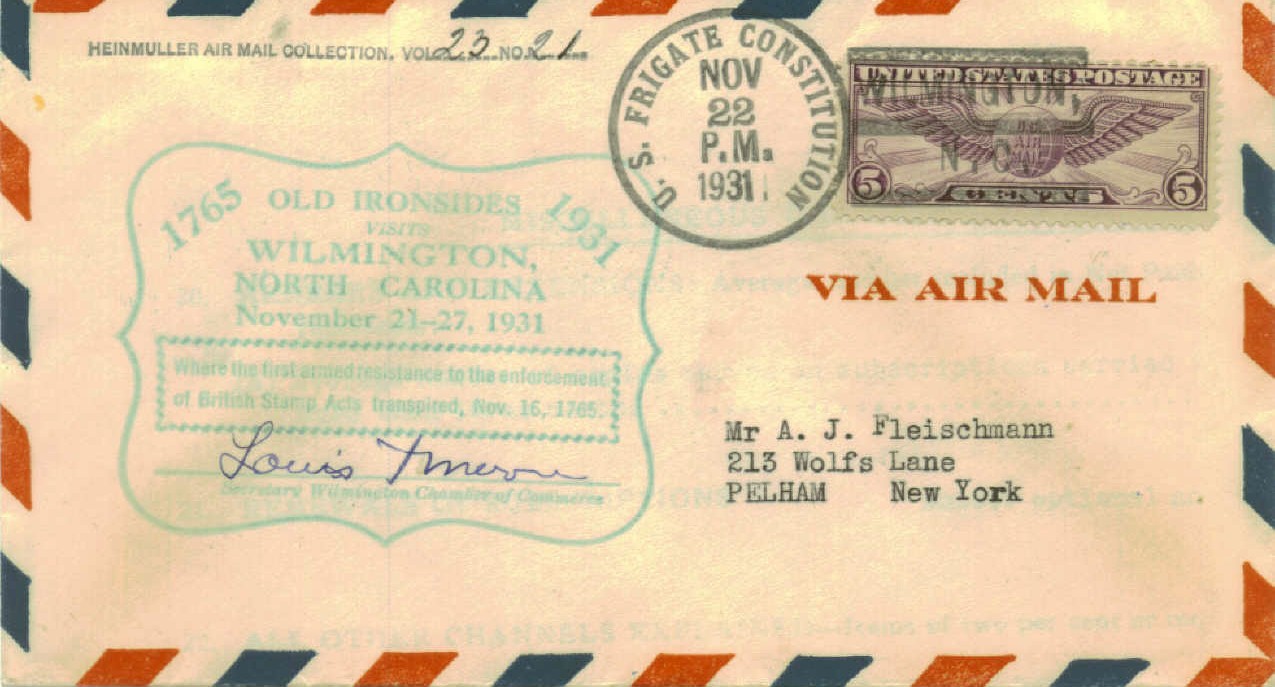
|
C-12 | An airmail cover sent on November 22, 1931 to AJ Fleischmann in Pelham NY. The cover commemorates the visit to Wilmington of the US Frigate Constitution (Old Ironsides) and is signed by Louis Moore, Secretary of the Wilmington Chamber of Commerce. | RP |
| 1932 |
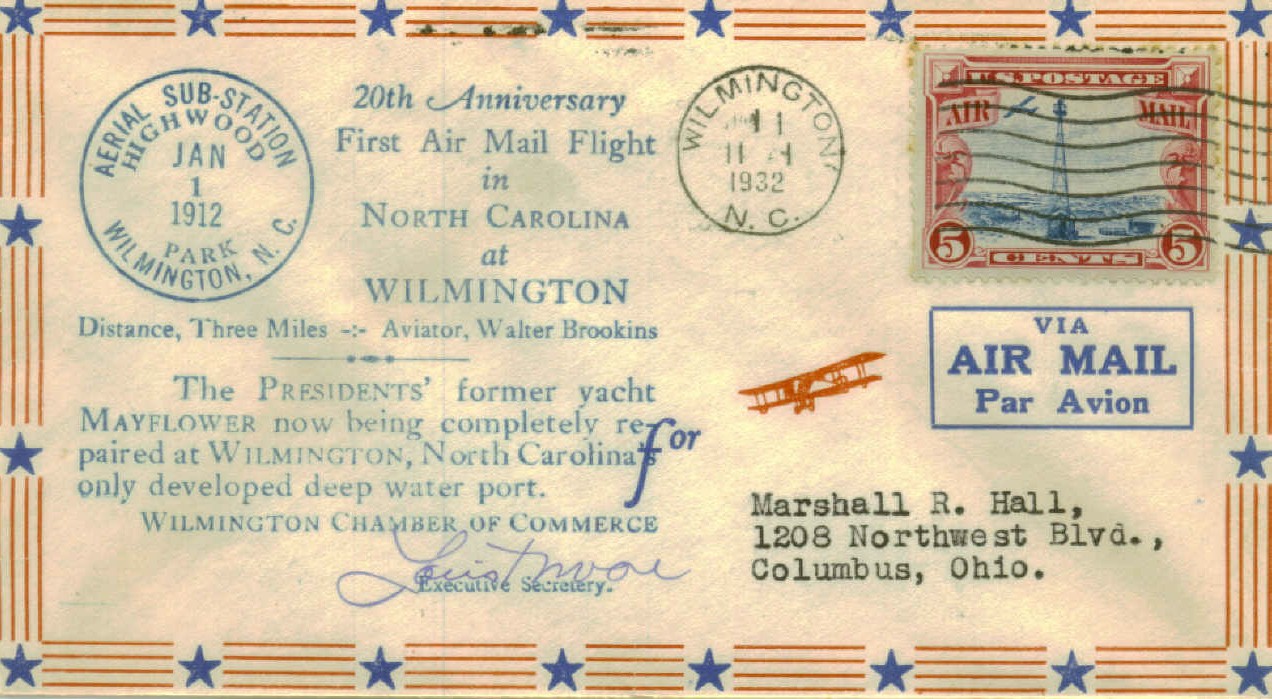
|
C-11 | An airmail cover sent on January 1, 1932 to Columbus OH. The cover commemorates the 20th anniversary of the first air mail flight in North Carolina at Wilmington. The cover is signed by Louis Moore, Secretary of the Wilmington Chamber of Commerce. See post card dated 1912 above for more details. | RP |
| 1932 |
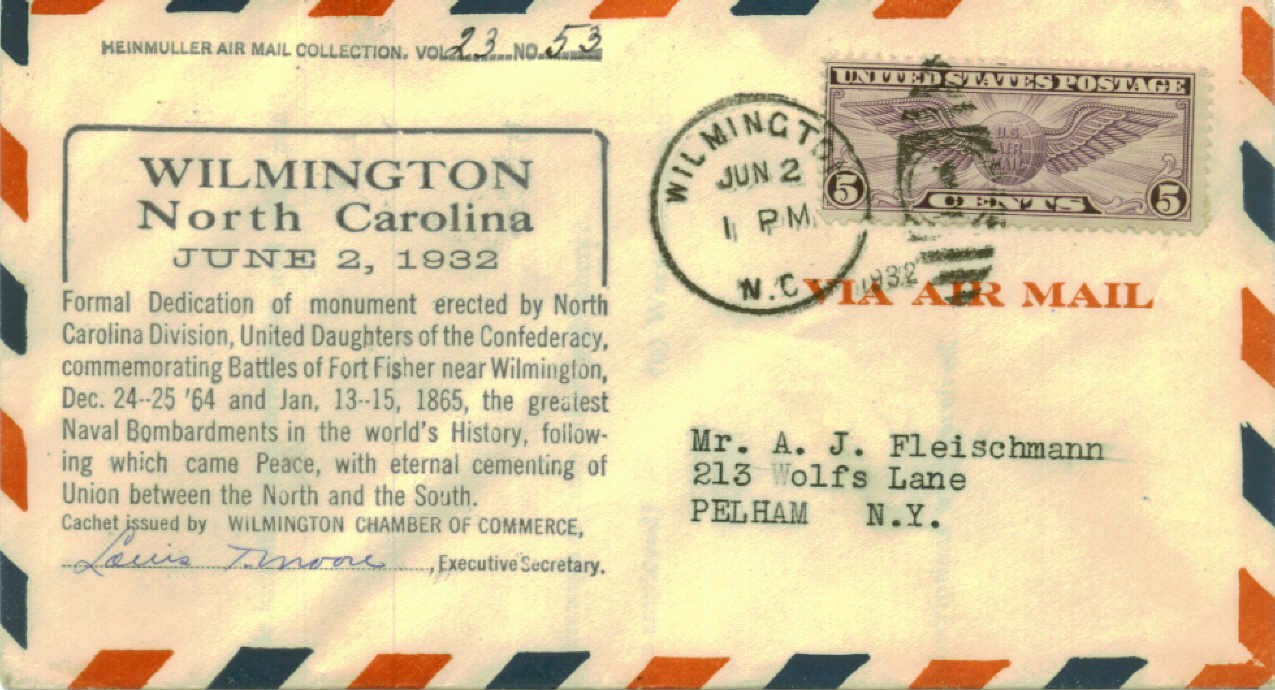
|
C-12 | An airmail cover sent on June 2, 1932 to Pelham NY. The cover commemorates the formal dedication of the monument erected by the North Carolina Division of the Daughters of the Confederacy. The monument commemorated the Battle of Fort Fisher near Wilmington which was the last battle of the Civil War. The cover is signed by Louis Moore, Secretary of the Wilmington Chamber of Commerce. | RP |
| 1932 |
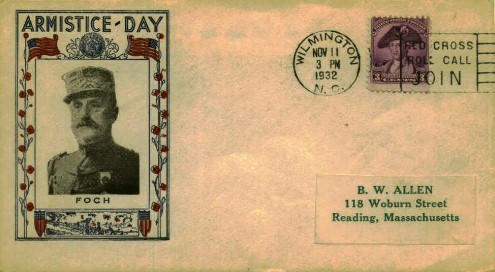
|
708 | A cover sent on November 11, 1932 from Wilmington to Reading MA. It commemorates Armistice Day, Ferdinand Foch and the end of WW-I. History: Armistice Day is the anniversary of the official end of WW-I on November 11, 1918. It commemorates the armistice signed between the Allies and Germany at Compiegne, France for the cessation of hostilities on the Western Front. It took effect at eleven o'clock in the morning — the "eleventh hour of the eleventh day of the eleventh month." Ferdinand Foch (October 2, 1851 – March 20, 1929), the supreme commander of the allied armies during WW-I accepted the German surrender at Compiegne. |
TB |
| 1933 |
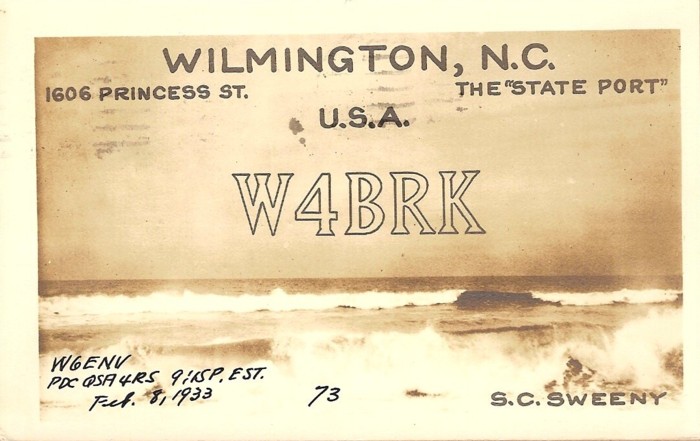
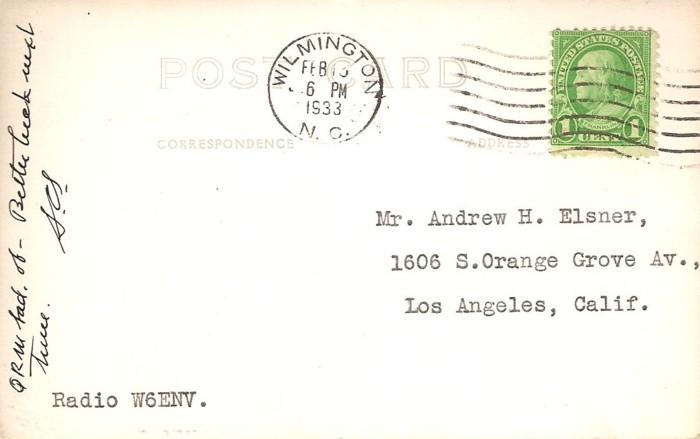
|
632 | A post card cancelled on February 13, 1933 and sent to Los Angeles CA. It advertises Ham Radio W4BRK in Wilmington NC. |
JJ |
| 1933 |
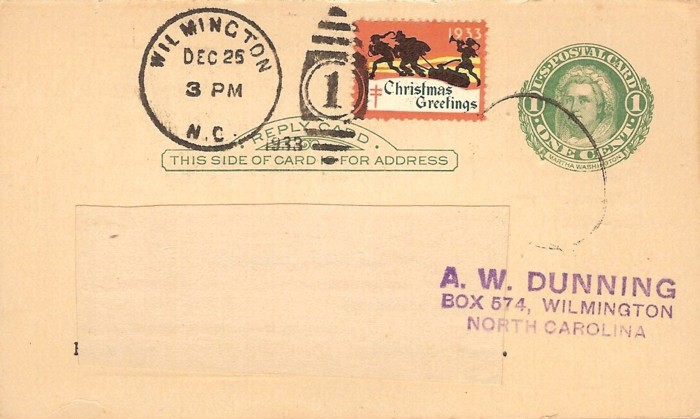
|
UY7r WX68 |
A postal reply card cancelled on December 25, 1933 and sent to Wilmington NC. It is a Christmas day usage of the 1933 Christmas Seal. |
JJ |
| 1934 |
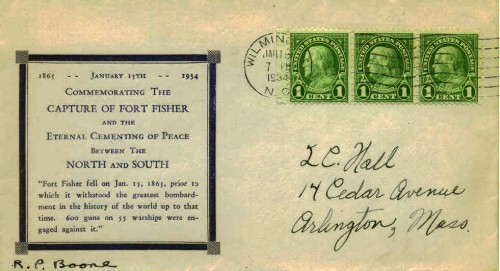
|
3x632 | A cover sent on January 15, 1934 from Wilmington to Arlington MA. It commemorates the capture of Fort Fisher, the last battle of the Civit War. History: Wilmington remained open until the last months of the Civil War. Finally, in January 1865, the Northern Union navy staged a massive bombardment and assault of Fort Fisher. Fort Fisher fell on January 15, 1865, followed by Wilmington a few weeks later. |
TB |
| 1934 |
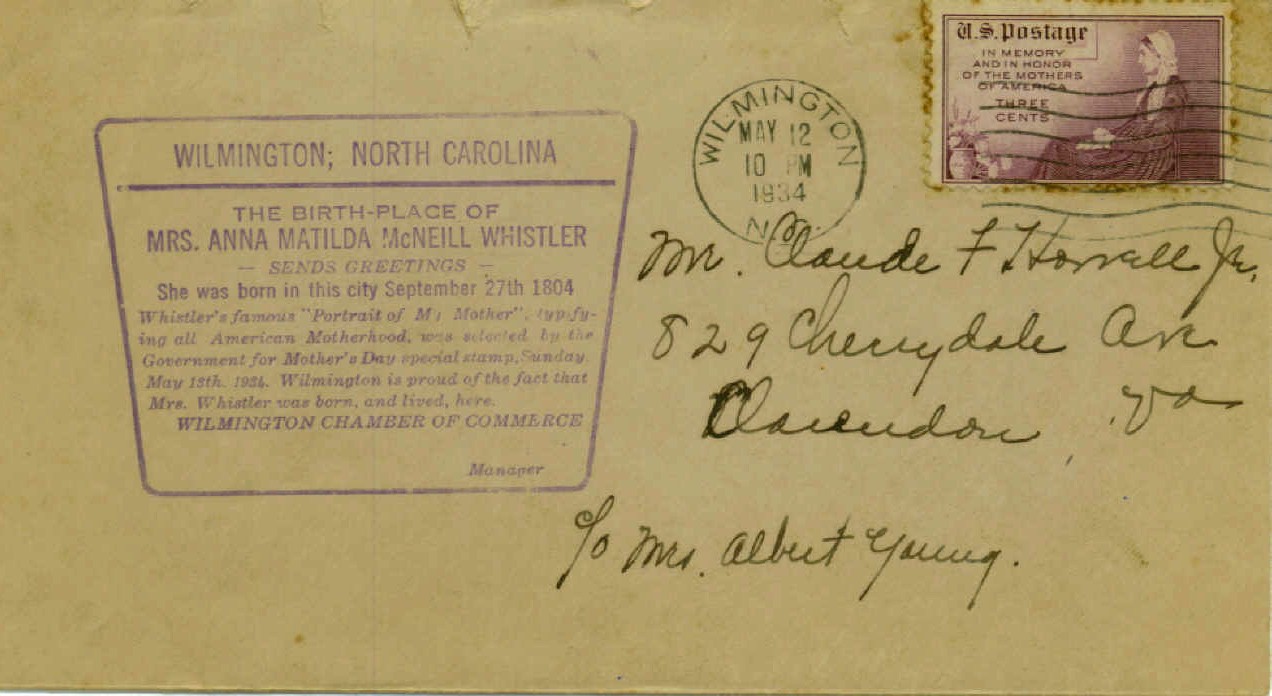
|
737 | A cover sent on May 12, 1934 to Claude Howell in Virginia. Wilmington was the home of Mrs Anna Matilda McNeill Whistler (Whistler's Mother). She was honored on a stamp that was issued on May 2, 1934 as a tribute to all mothers in America. History: Claude Flynn Howell was a noteworthy artist who was born in Wilmington in 1915. He spent his early summers in Rockport ME and Woodstock NY studying painting with other noted artists but always called Willington his home. Howell has been characterized as the "Dean of North Carolina Painters." He had a widespread influence on the arts in North Carolina through his painting, murals, and as an educator. He taught art at Wilmington College (now UNCW) and his classes at UNCW led to the formation of an Art Department, for which he became the director. He passed away in 1997. |
RP |
| 1934 |
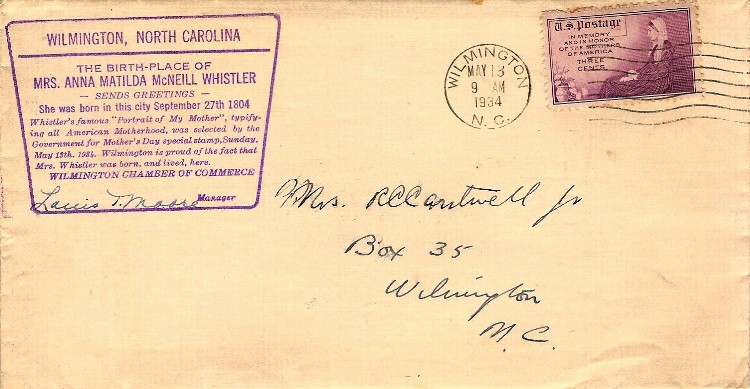
|
737 | A cover canceled on Mother's Day, May 13, 1924 (2nd Sunday of May) at Wilmington NC and sent to RC Cantwell Jr in Wilmington NC. History: Mother's Day is centuries old and goes back to the times of ancient Greeks who held festivities to honor Rhea, the mother of the gods. The early Christians celebrated the Mother's festival on the fourth Sunday of Lent to honor Mary, the mother of Christ. Later a religious order stretched the holiday to include all mothers and named it as the Mothering Sunday. In 1872 Julia Ward Howe organized a day for mothers dedicated to peace. In 1907 Anna M Jarvis, a Philadelphia schoolteacher began a movement to set up a national Mother's Day in honor of her mother. She solicited the help of hundreds of legislators and prominent businessmen to create a special day to honor mothers. The first Mother's Day observance was a church service honoring Anna's mother. Anna handed out her mother's favorite flowers (white incarnations) on the occasion as they represent sweetness, purity and patience. In 1914 President Woodrow Wilson proclaimed the second Sunday in May as a national holiday in honor of mothers. Over the years Mother's day became very popular and gift giving activity increased. Mother's Day has flourished in the US and the second Sunday of May has become one of the most popular days of the year. Wilmington NC was the home of Mrs Anna Matilda McNeill Whistler (Whistler's Mother). She was honored on a stamp that was issued as a tribute to all mothers in America. The stamp shows a reproduction of the painting by James Abbot McNeill Whistler entitled, "Portrait of My Mother." The stamp (Scott #737 & 738) was first placed on sale on May 2, 1934 and is known as the Mother's Day stamp. |
LS |
| 1934 |
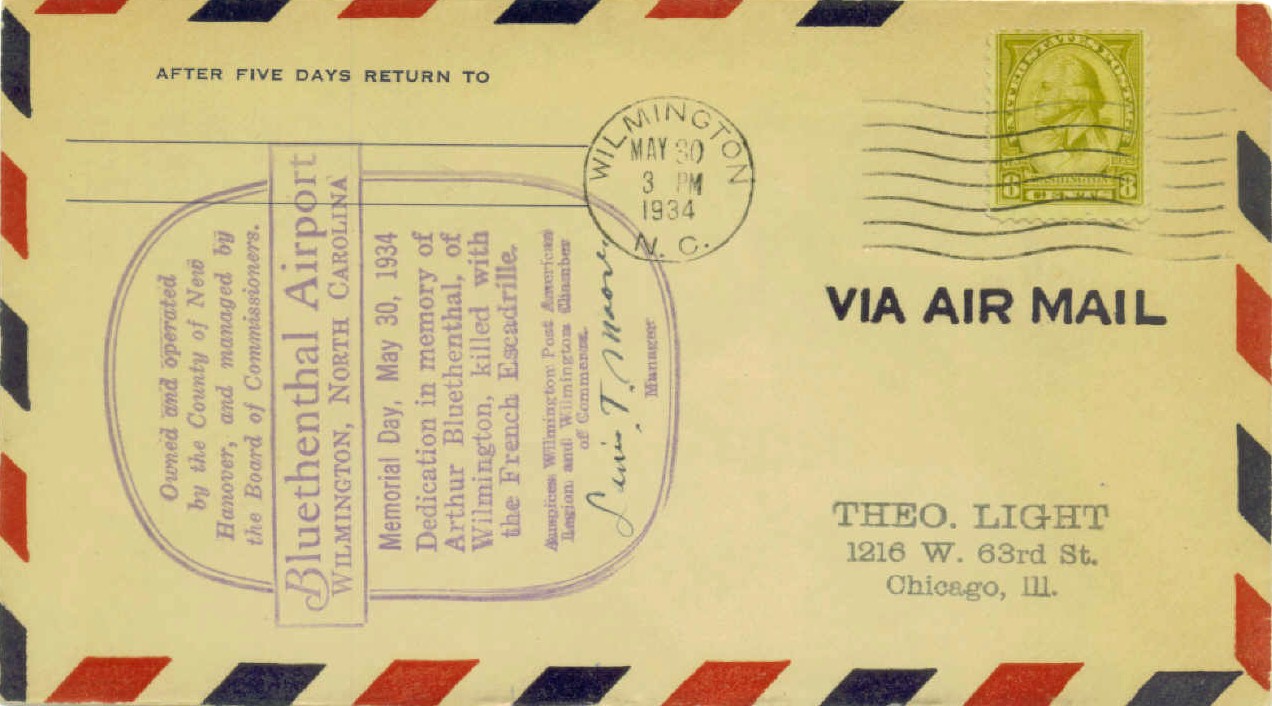
|
713 | An airmail cover sent on May 30, 1934 to Theo Light in Chicago IL. The cover commemorates the formal dedication of Bluethenthal Airport which served the needs of Wilmington. It is signed by Louis Moore, Secretary of the Wilmington Chamber of Commerce. History: The airfield was named in the memory of Arthur Bluethemthal who was born on November 1, 1891 in Wilmington and killed in France on June 5, 1918 while serving with the Lafayette Flying Corps during WW-I. Bluethenthal Airfield was carved out of dairy farmland adjacent to the Wightsboro-Winter Park Road (now Kerr Avenue). New Hanover County employed the services of Lt HW Holden, commanding officer of Pope Field in Fort Bragg NC to lay out two grass runways, one 1,700 feet and the other 1,750 feet long. Initially the airport had no lighting, no hangers, no spare parts or service crews and repair facilities. Coastal Plains Airways provided the first passenger service at Bluethenthal Airfield. Warren Kinchen Pennington was its manager/pilot. Coastal Plains later became Port City Flying Service, then Sea Level Airways and eventually evolved into Pennington Flying Service. In 1942 Bluethenthal Airfield was taken over by the US Army Air Corps and became the Wilmington Army Airport. The Pennington's moved their commercial air operations to Carolina Beach Airport which was located about a mile north of Snow's Cut (a bit north of Carolina Beach). The Army Air Corps enlarged the airport paving all runways (extended to 7,000 and 7,999 feet long) and added and improved all its facilities. After WW-II ended, the military returned the airport in 1946 to the County and it became the New Hanover County Airport. The County appointed an Airport Board to manage the airport leading to conflicts between County ownership of the land and buildings and the Borad's management responsibilities. Southeast Airlines was the first airline after WW-II to serve Wilmington followed by National Airlines. In 1966 the military returned to the airport when the 444th Fighter Interceptor Squadron of the Air Defense Command located F-101 aircraft and support facilities on the east side of the field. The Air Force operations continued through 1974. New Hanover County Airport was re-named the "Wilmington International Airport" in 1997. Visit the Wilmington International Airport (ILM). |
RP |
| 1935 |
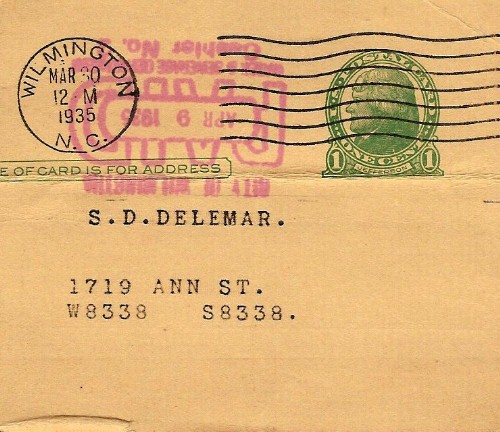
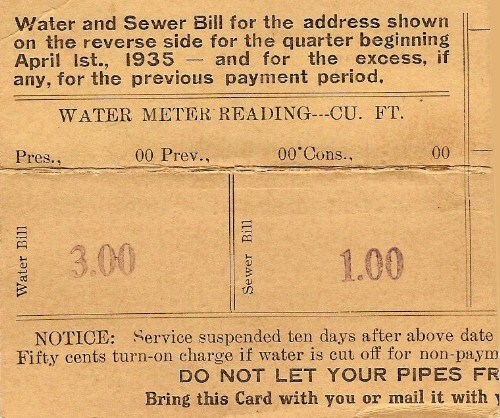
|
UX-27 | A postal card sent on March 30, 1935 as the bill for water and sewer quarterly services. History: During the 20th century Wilmington became an industrial center. With annexations in the 1990s the city of Wilmington grew to cover an area of New Hanover County from the Cape Fear River to the Intracoastal Waterway and from Smith Creek to the intersection of South College and Carolina Beach roads. Amongst various services, the city provides water and sewer utilities, garbage collection, fire and police protection, street maintenance, traffic control, parks and recreation facilities. New Hanover County is sandwiched between Pender and Brunswick counties, the Cape Fear River and the Atlantic Ocean covering 199 square miles. Amongst various services, the county provides water and sewer utilities, fire protection, libraries, parks, sheriff's protection, jails, courts, commissioners managing Hanover Regional Hospital and Wilmington International Airport and a public school system managed by an elected Board of Education. On March 17, 1942 Wilmington entered the bond market to finance its water and sewer improvements. In 1970 the Wilmington-New Hanover County Water and Sewer Authority was created to plan and develop dependable water and sewer systems. It became apparent the program and objectives for a water supply were regional in scope and the Authority was expanded in 1972 to become the Lower Cape Fear Water and Sewer Authority. On July 1, 2008 the city of Wilmington and New Hanover County merged their water and sewer systems to create the Cape Fear Public Utility Authority (CFPUA). CFPUA is an independent, local government entity formed to more efficiently and effectively provide water and sewer services to both city and county residents. |
RP |
| 1936 |
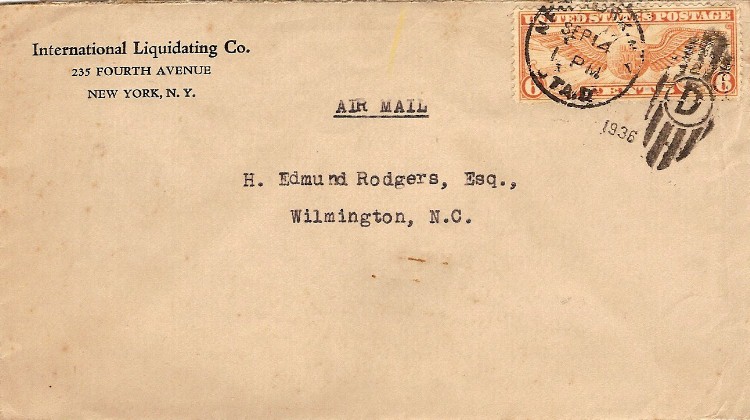
|
C-19 | A cover canceled on September 14, 1936 at New York NY and sent to H Edmund Rodgers Esq in Wilmington NC. History: See above cover - 1916 |
LS |
| 1937 |
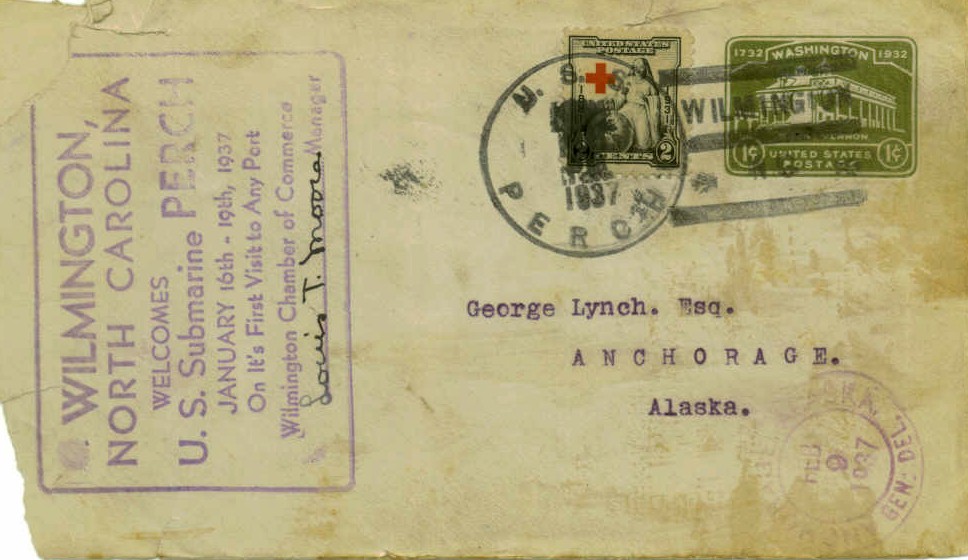
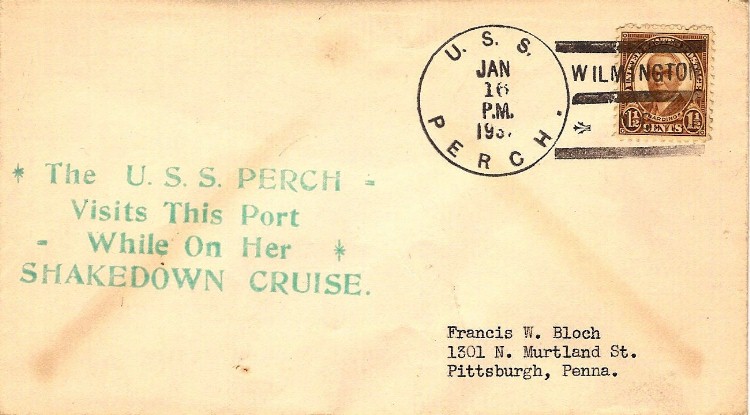
|
U-523 702 684 |
A cover sent from the submarine, USS Perch visiting Wilmington NC on January 16, 1937 to George Lynch in Anchorage AK. Wilmington NC was the first port-of-call for the USS Perch before it began its service in the Pacific before the start of WW-II. History: The USS Perch (SS-176) was a Porpoise-class submarine of the US Navy. Her keel was laid on February 25, 1935 by the Electric Boat Company in Groton CT. She was launched on May 9, 1936 and commissioned on November 19, 1936 with Lieutenant Commander George C "Turkey Neck" Crawford in command. On February 3, 1942 the Perch departed Port Darwin Australia on its 2nd patrol into the Java Sea. At this time Japan was on its campaign to conquer the Netherlands East Indies (Indonesia). The Perch took a Japanese shell to her conning tower on February 25th damaging her communication abilities. A few days later the Perch encountered two Japanese destroyers. She dived but was hit by depth charges losing her port screw. On March 2nd she surfaced and was seriously injured with leaks preventing another dive. On March 3, 1942 the Perch crew was ordered to abandon ship and to scuttle their sub. The entire crew was captured by the Japanese and on March 10th taken to a prison camp at Makkasser Clebes, Dutch West Indies. Six crewmembers died in captivity and the remaining 53 were handed over to the US at the end of WW-II. |
TB JJ |
| 1937 |
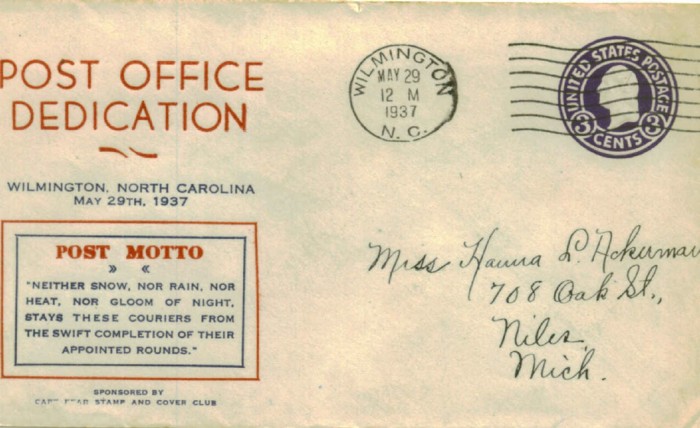
|
U-436 | A cover sent on May 29, 1937 to Hanna Akerman in Niles MI. It commemorates the dedication of the new main post office in Wilmington.
History: On July 26, 1775 the Second Continental Congress meeting in Philadelphia established an American Post Office with Ben Franklin as Postmaster General. It provided a line of posts from Falmouth in New England to Savannah, Georgia. Several years later on October 5, 1789 the first postmaster, John Bradley was assigned to Wilmington to operate the post office as a colonial office. Early Wilmington post offices were located in stores and hotels and the Postmasters were paid by a percentage of the mail they processed. The first post office in Wilmington was located in the old Custom House which was completed in 1846. It remained in that Federal Building until 1874 when a two-story brick building was erected on the southwest corner of Second and Chestnut Streets. In 1888 the construction of a main post office began on the site of the former home of RR Bridges at the corner of Front and Chestnut Streets. It was completed in 1891 and was made of brown granite from Wadesboro NC. It had two faces carved over the entrance, one happy and the other, dejected. Patrons rumored that one face had received a letter and the other received none. It was locally called the, "Brownstone Post Office." As Wilmington grew, it was necessary to construct a new downtown main post office. The cornerstone was laid on September 27, 1936 and the new post office was dedicated on May 29, 1937. Its lobby contains a mural painted in 1940 by William F Pfohl depicting the historic Wilmington waterfront. |
RP |
| 1937 |
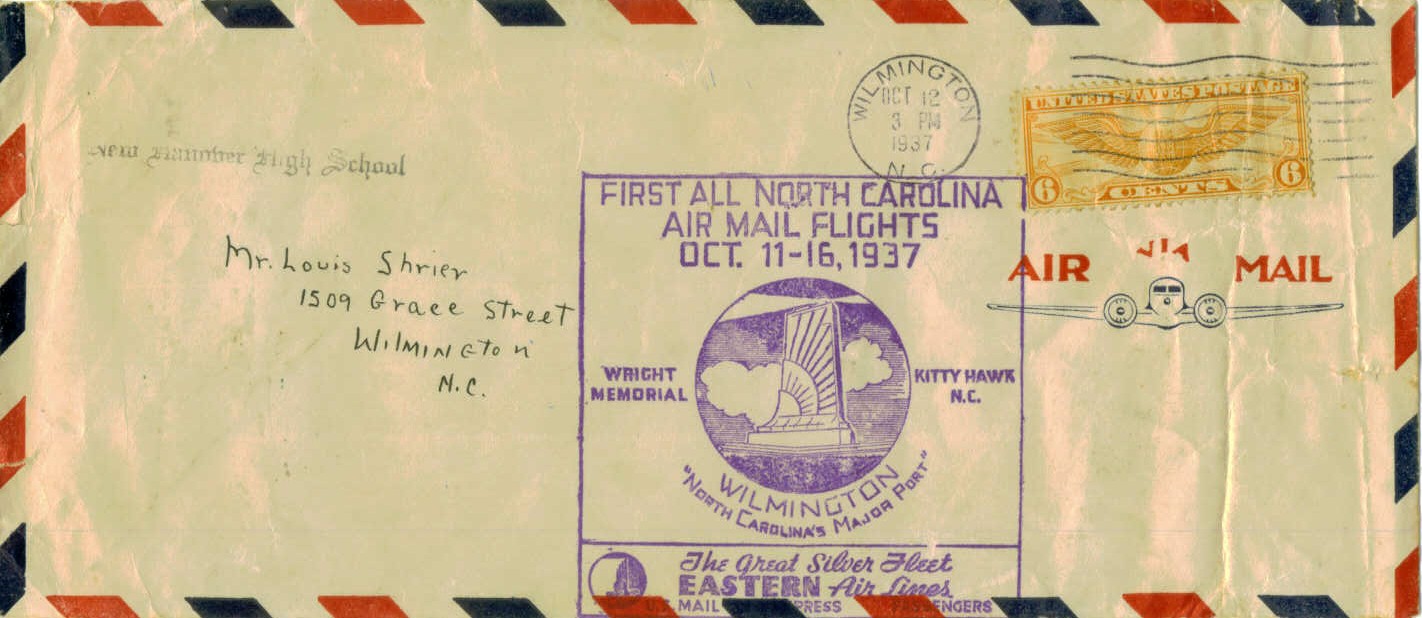
|
C-19 | An airmail cover sent on October 12, 1937 from Wilmington to Wilmington. The cover commemorates the first All-North Carolina Air Mail Flights that occurred between October 11th and 16th (North Carolina Air Mail Week). During that week a special flight was made from Kitty Hawk NC. The Post Office Department authorized additional NC flights to other NC cities using Eastern Airlines (Route #6 - Wilmington). | RP |
| 1938 |
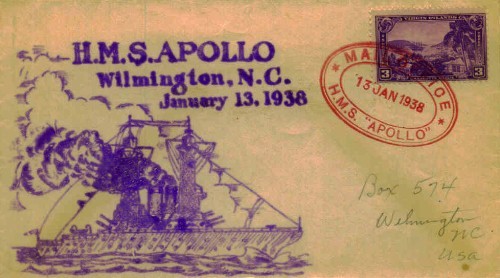
|
802 | An cover sent on January 13, 1938 from the visiting HMS Apollo to Wilmington. The cover commemorates the visit of the HMS Apollo to Wilmington on its way to Miami FL. History: HMS Apollo, a light cruiser was built at Devonport, England. It was the first of a class of three cruisers all of which served in the Royal Australian Navy. The Apollo was completed in January 1936 and operated in North America and West Indies waters. On January 13, 1938 the Apollo visited Wilmington proceeding on to Miami FL on February 1, 1938. The Apollo was transferred to Australia in late September 1938 where she was renamed the HMAS Hobart. Following the outbreak of war with Germany (September 1939), the Hobart cruised off Australia in the East Indies and in the Indian Ocean to protect troop convoys en route to the war zone and to guard against the threat of enemy surface raiders. In April 1940 she went to the Red Sea, where she operated against Italian forces for several months. The cruiser served in the Mediterranean Sea during the last half of 1941, but was withdrawn when Japan attacked Pearl Harbor on December 7, 1941. She spent the rest of WW-II in the Pacific. Her activities in 1942 included participation in the Battle of the Coral Sea in May and the invasion of Guadalcanal and Tulagi in August. The Hobart also operated extensively in the Coral Sea area, covering the Allies' vital south Pacific supply lines and protecting New Guinea from enemy surface threats. While steaming west of the New Hebrides on July 20, 1943, in company with an Australian heavy cruiser and three US Navy destroyers, she was torpedoed by a Japanese submarine. Her after-hull was seriously damaged, necessitating prolonged repairs at Sydney that kept her out of service until December 1944. During the rest of WW-II the Hobart served in the Philippines and East Indies, taking part in amphibious landings at Cebu in March 1945 and Borneo in April-July. When Japan surrendered on September 2, 1945, she was part of the fleet anchored in Tokyo Bay to witness the event. Following the end of hostilities, the Hobart participated in the occupation of Japan for two years. She was decommissioned in December 1947 and placed in reserve. In 1953, she began conversion and modernization to prepare her for service as the Royal Australian Navy's training cruiser. This mission was canceled in 1956 and she was returned to reserve. The HMAS Hobart was sold for scrap in February 1962 and was subsequently broken up in Japan. |
TB |
| 1938 |
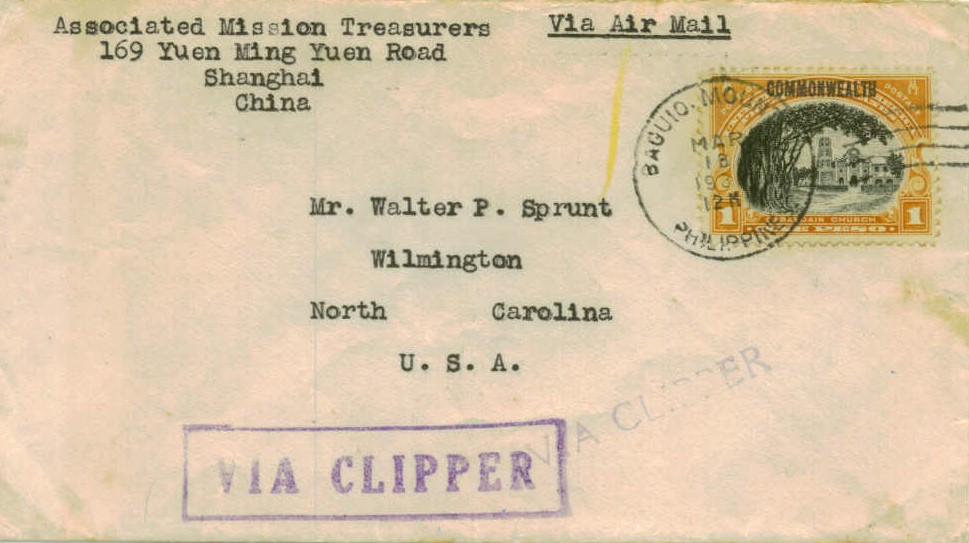
|
393 | An air mail cover carried from
Associated Mission Treasures in Shanghai China to Baguio Philippines where it was sent via Pan American Clipper on
March 18, 1938 to Walter P Sprunt in Wilmington NC.
Clipper mail was flown across the Pacific on Pan Am's Martin M-130 sea-plane.
History: In Wilmington just south of Bradley Creek Point, east of Shandy Hall and opposite Greenville Sound on the mainland is Money Island. It is rumored that privateer and alleged pirate, Captain William Kidd buried treasure on Money Island as he sailed from the Caribbean to New York in 1699. From time to time, local residents and fortune-seekers from afar have shoveled Money Island's dirt searching for Kidd's treasure. Kidd was eventually arrested in Boston MA in 1699, shipped to England in 1700 where he was publically hanged in London in 1701 taking knowledge of his hidden buried treasurers to his grave. Dr George Worth (1867-1936) was a Wilmington native and a medical missionary in Shanghai China. On his periodic furloughs back to Wilmington, he would bring Chinese trinkets which he salted about on his Money Island. He would take relatives and friends and stage fantasy mock treasure hunts by night. His daughter, Julia married Walter Payne Sprunt Jr (1914-1983) and they continued ownership of Shandy Hall and Money Island. The legend of Money Island and Captain Kidd was spawned in 1918 when the World Film Corporation filmed a movie in Wilmington entitled "Pirate's Gold." Soon thereafter architect, Kenneth M Murchison, related to the Worth's and a frequent visitor to Wilmington and Shandy Hall, published a piece of sheet music in 1920 entitled "Captain Kidd" in which Chinese items were a prominent part of his lyrics. The legend of Captain Kidd was made into a popular 1945 movie, "Captain Kidd" starring Charles Laughton as Kidd. |
RP |
| 1938 |
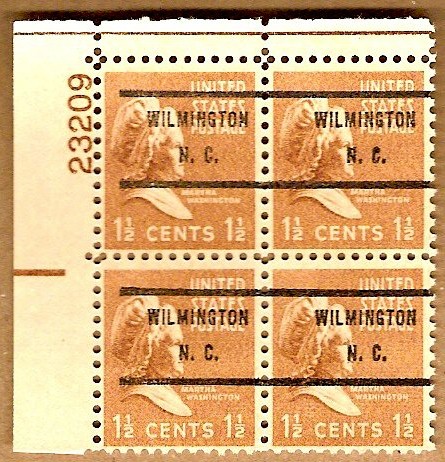
|
805 | A plate block pre-canceled in Wilmington NC. The 1 1/2 cent stamp was first issued on May 5, 1938 and bears a representation of Martha Washington. It is one stamp in a series of presidential issues. History: A precancelled stamp (aka precancel) is a postage stamp that has been cancelled before being affixed to mail. Precancels are used by mass mailers, who can save the post office time and effort by prearranging to use precancel stamps and delivering this mail ready for sorting. The Post Office experimented with precancelled stamps in an effort to reduce their work load. This bulk stamped mail would not have to go through the cancellation machine. Precancels cannot be purchased by the general public. To precancel stamps the city and state were printed on the face of the stamp. This also made it difficult if someone stole the stamps to resell/use them in another location. |
JJ |
| 1938 |
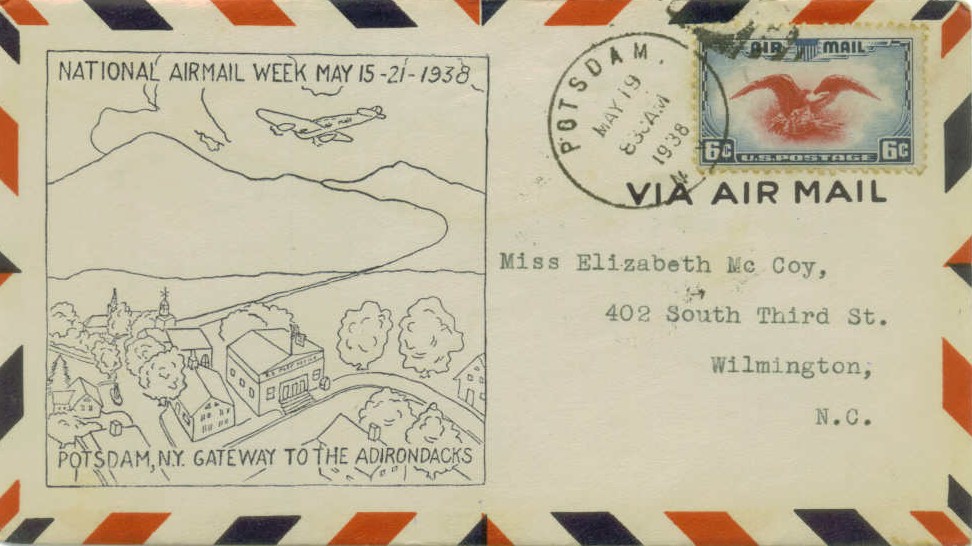
|
C-23 | An airmail cover sent on May 19, 1938 from Potsdam NY to Wilmington. The cover was sent during "National Airmail Week" celebrated across the US during May 15/21, 1938. A similar National Air Mail Week air mail cover sent from Wilmington to Wilmington via Raleigh NC. | RP |
| 1938 |
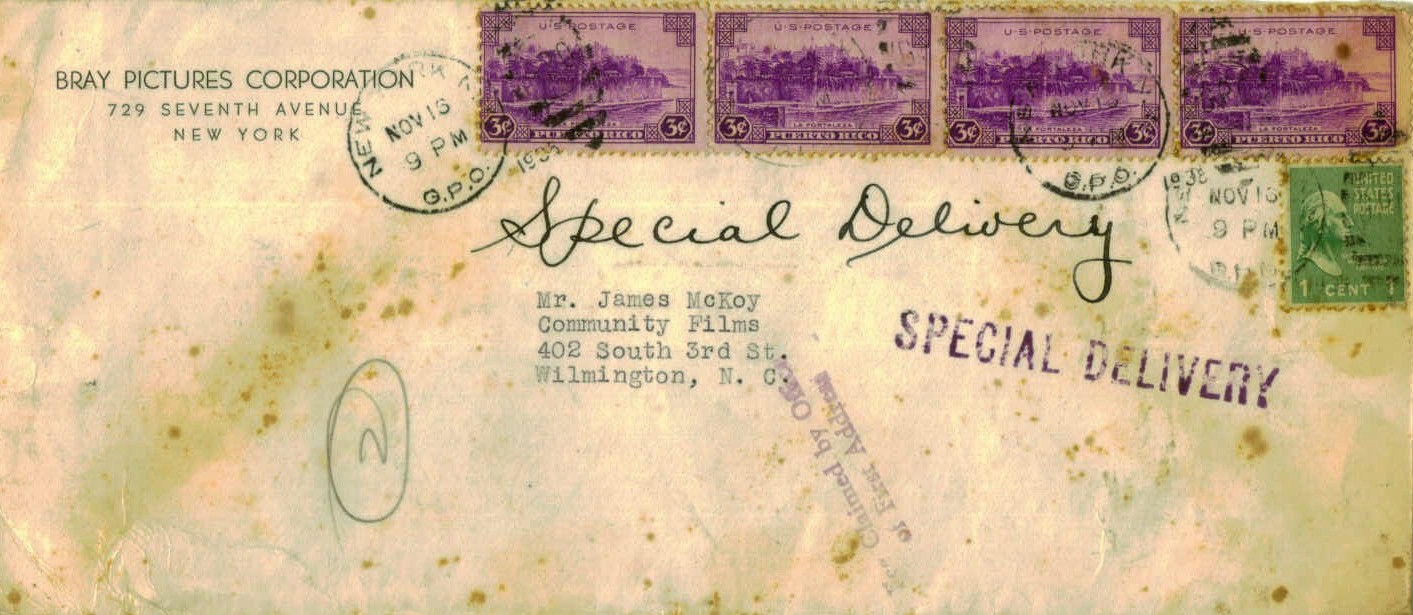
|
801x4 804 |
A special delivery cover sent on November 16, 1938 from Bray Pictures Corporation in NYC to James McKoy in Wilmington NC. History: James Hasell McKoy was born in 1902 and became a lifelong devotee of the dramatic arts. As a young man McKoy studied at "The Inter-Theatre Arts," in New York City. He managed theaters throughout the eastern US and headed "Community Films" here in Wilmington. Community Films had dealings with the theatre-chain, Paramount Publix Corporation, the Roxy Theatre and Bray Pictures Corporation who made screen magazines, educational and training films. McKoy was active with "North Carolina Theatres" in Greensboro NC. He worked with the Victor Animatograph Corporation, maker of projection equipment and in 1943, he opened Saint John's Tavern in Wilmington's old Saint John's Masonic Lodge. Wilmington's Thalian Hall had several close calls with demolition in the 1930's and 40's but McKoy with other citizens of the community successfully rallied for its preservation. McKoy died in 1964. |
RP |
| 1939 |
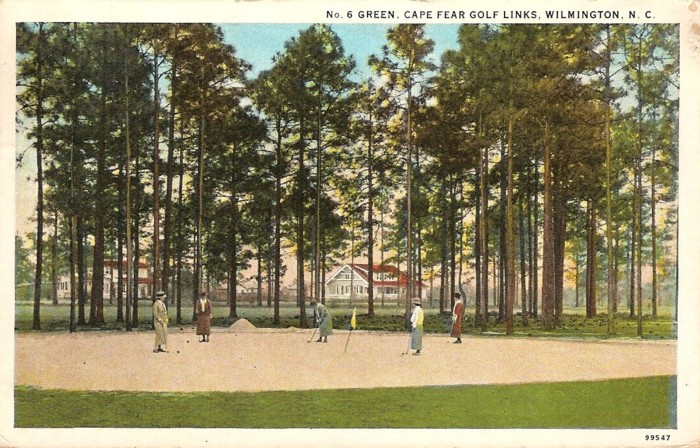
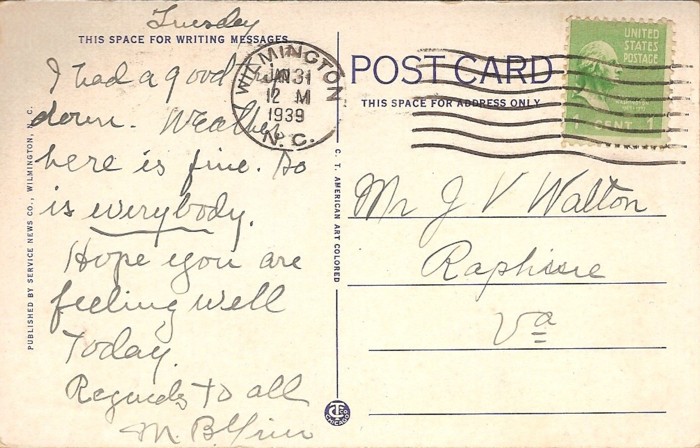
|
804 | A post card cancelled on January 31, 1939 and sent to Raphine VA. It shows the Cape Fear Golf Links in Wilmington NC. |
JJ |
| 1939 |
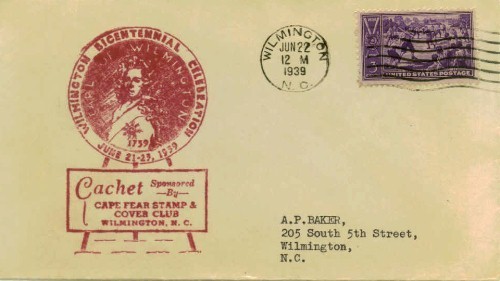
|
855 | A cover sent on June 22, 1939 to AP Baker in Wilmington. It commemorates Wilmington's Bicentennial Celebration. The town of Wilmington was incorporated in 1739 and in 1939 became 200 years old. The cachet on this cover was prepared by the Cape Fear Stamp & Cover Club. On the rear of the cover is a "Wilmington Vacation Land" label. |
WT |
| 1939 |
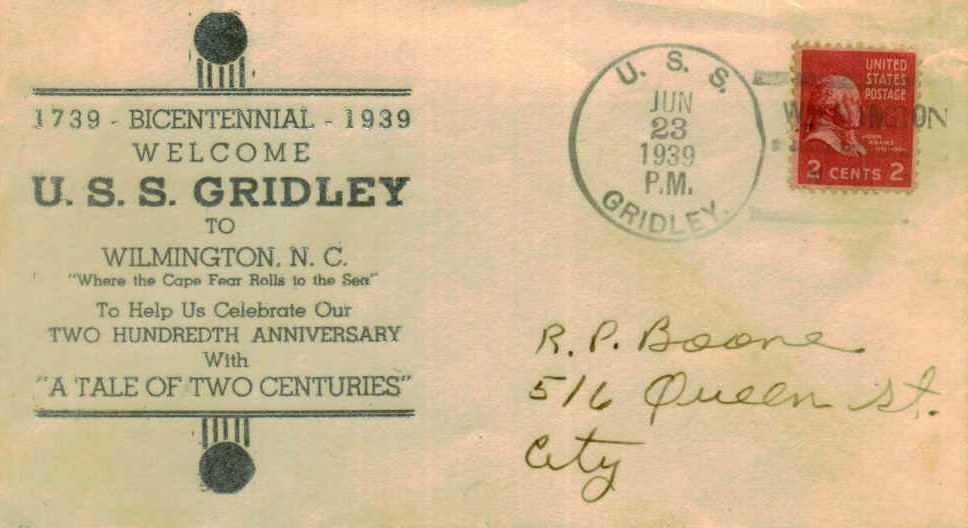
|
806 | A cover sent on June23, 1940 from the USS Gridley in Wilmington to Wilmington NC. It commemorates the visit of the destroyer, USS Gridley to the port of Wilmington as part of Wilmington's Bicentenial Celebration. History: The second USS Gridley (DD-380) was the lead ship of her class of destroyers in the US Navy. She was named for Charles Vernon Gridley. The Gridley's keel was laid on June 3, 1935 at the Boston Navy Yard. She was launched on December 1, 1936 and commissioned on June 24, 1937. After shakedown in the Caribbean she transited the Panama Canal and entered San Diego harbor on July 5, 1938 returning to the Caribbean in January 1939 and then to Boston for repairs. On her return to San Diego, on June 23, 1939 the Gridley visited the port of Wilmington NC to help celebrate Wilmington Bicentennial. She continued on via the Panama Canal to San Diego CA and in April 1940 began operations out of Hawaii. After the Japanese attack on Pearl Harbor the Gridley returned to Pearl Harbor to help protect against renewed attack and during the next five months escorted transports and repair vessels to and from Pearl Harbor and South Pacific ports. She teamed with destroyer Maury to escort infantry landing craft from Guadalcanal for the landings on Tambatuni, New Georgia. She sailed with the Hornet task force on June 7, 1944 to take part in the invasion of the Marianas, where US carriers pounded Saipan, Rota, and Guam. The Gridley and her sister destroyers rendered invaluable service protecting the carriers against air and submarine attack. The Gridley was with American forces in the pivotal Battle of the Philippine Sea (June 19-20, 1944) providing antiaircraft fire protecting US aircraft carriers. She departed Eniwetok Atoll on June 30, 1944 bound with US carriers for strikes on Iwo Jima, Guam, Yap, Ulithi and the Volcano Islands. She screened the US carriers in attacks on Okinawa and Formosa and then joined the mounting American forces for the invasion of the Philippines. While protecting the large ships off Luzon on October 28, 1944 she and destroyer Helm detected and sank Japanese submarine I-51f with a series of devastating depth charge attacks. In the succeeding days she fought off Japanese suicide planes and returned to Ulithi with damaged carriers Franklin and Belleau Wood on November 2, 1944. The Gridley escorted battleship Mississippi to Pearl Harbor and then sailed via San Diego and the Panama Canal for New York arriving there on March 30, 1945. She entered the New York Navy Yard for repairs. The USS Gridley was decommissioned on April 18, 1946. Charles Vernon Gridley was born November 24, 1844 in Logansport IN and was appointed to the Naval Academy in 1860. In the Civil War he joined the sloop-of-war Oneida with the West Gulf Blockading Squadron and distinguished himself with Farragut at the Battle of Mobile Bay on August 5, 1864. After the Civil War he was promoted to Lieutenant in 1867 and Commander in 1882 spending the next 30 years at various stations around the world including a tour as instructor at the Naval Academy. Captain Gridley took command of the Olympia (Admiral Dewey's famous flagship) on April 27, 1898, a post which he held despite his failing health during the Battle of Manila Bay on May 1, 1898. After the destruction of the Spanish squadron and the capture of Manila, Gridley left his command because of ill-health and died en route to the US at Kobe, Japan on May 25 1898. |
TB |
| 1939 |
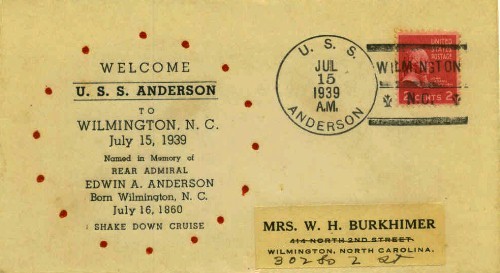
|
806 | An cover sent on July 15, 1939 to Mrs Burkhimer in Wilmington. The cover commemorates the visit to Wilmington of the USS Anderson on its shake-down cruise before entering naval service. History: Edwin Alexander Anderson was born on July 16, 1860 in Wilmington NC. He graduated from the US Naval Academy in 1882, was appointed Ensign on July 1, 1884 and promoted through the ranks to Rear Admiral on November 28, 1918. He had a distinguished military career retiring from active duty in 1923. He died at his home in Wilmington on September 23, 1933 and was buried in Arlington National Cemetery. The USS Anderson (DD-411) was named for him. USS Anderson, a Sims class destroyer was built at Kearny, NJ and commissioned in May 1939. On July 15, 1939 the destroyer made a shake-down cruise to Wilmington before serving in the Atlantic and Caribbean areas through April 1940 and thence was assigned to the Pacific. The Anderson remained in the south-Pacific, screening heavy ships, escorting convoys, bombarding the enemy ashore and carrying out patrols. She returned to the US for overhaul in March 1943 and afterwards supported the invasions of the Gilbert Islands in November 1943 and the Marshalls in early 1944. She was hit by Japanese coast-defense gunfire while bombarding Wotje on January 30, 1944 and was hit by a Japanese suicide plane on November 1, 1944 causing her to again return to the US for repair. Following Japan's surrender, the Anderson took part in occupation activities for a few months before steaming eastward across the Pacific to San Diego CA. In early 1946, she voyaged back to Pearl Harbor and then proceeded on to the Marshall Islands for use as a target ship in "Operation Crossroads" nuclear weapons tests. The USS Anderson was sunk on July 1, 1946 by the "Able" atomic bomb explosion at Bikini Atoll. |
TB |
| 1939 |
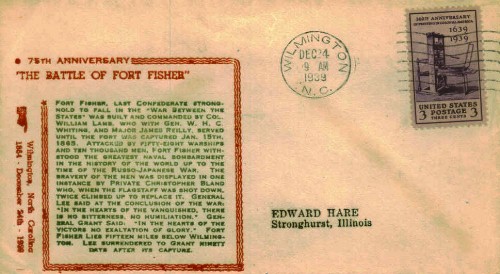
|
857 | A cover sent on December 24, 1939 from Wilmington to Stronghurst IL. It commemorates the 75th Anniversary of the first attack by the north's joint Army-Navy forces to capture Fort Fisher, the last battle of the Civit War. History: Wilmington remained open until the last months of the Civil War. Finally, in January 1865, the Northern Union navy staged a massive bombardment and assault of Fort Fisher. Fort Fisher fell on January 15, 1865, followed by Wilmington a few weeks later. |
TB |
| 1940 |
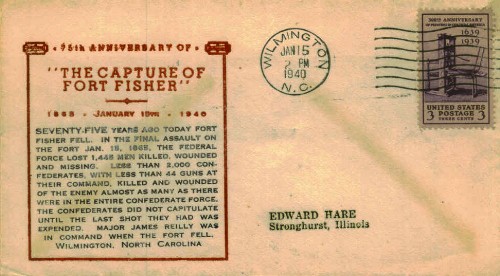
|
857 | A cover sent on January 15, 1940 from Wilmington to Stronghurst IL. It commemorates the capture of Fort Fisher, the last battle of the Civit War. History: Wilmington remained open until the last months of the Civil War. Finally, in January 1865, the Northern Union navy staged a massive bombardment and assault of Fort Fisher. Fort Fisher fell on January 15, 1865, followed by Wilmington a few weeks later. |
TB |
| 1940 |
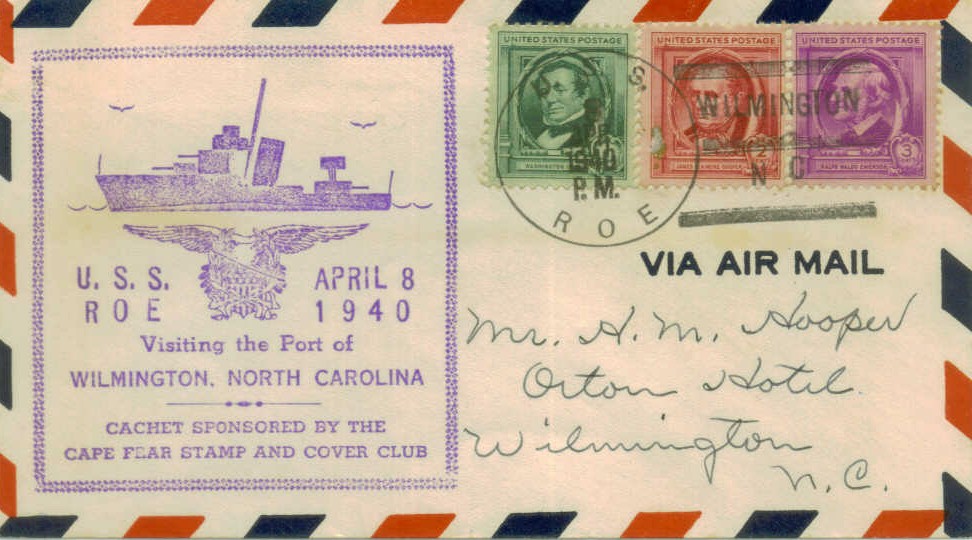
|
859,860 & 861 |
A cover sent on April 4, 1940 from the USS Roe in Wilmington to Wilmington NC. It commemorates the visit of the USS Roe to the port of Wilmington. History: The Destroyer, USS Roe (DD-418) had its keel laid on April 23, 1938 at the Charleston Navy Yard, Charleston SC. She was launched on June 21, 1939 and commissioned January 5, 1940. Under the command of Lieutenant Commander RM Scruggs the USS Roe visited Wilmington NC on April 8, 1940. Following shakedown, the USS Roe conducted exercises along the east coast of the US before serving in the Mediterranean and in 1944 she was transferred to the Pacific. She earned six battle stars during WW-II returning to San Francisco after VJ Day. She was decommissioned October 30, 1945. Francis Asbury Roe was born October 4, 1823 at Elmira NY and was graduated from Annapolis in 1848. During the Civil War in April 1862, Roe was recommended for promotion for gallantry for his actions on board Pensacola while serving as executive officer. He commanded the Sassacus as part of the North Atlantic Blockading Squadron in September 1863 capturing and destroying several blockade runners in the sounds of North Carolina. He was promoted to Rear Admiral on November 3, 1884 while serving as Governor of the Naval Asylum at Philadelphia PA. He died in Washington DC on December 28,1901 and is buried in Arlington National Cemetery. |
TB |
| 1940 |
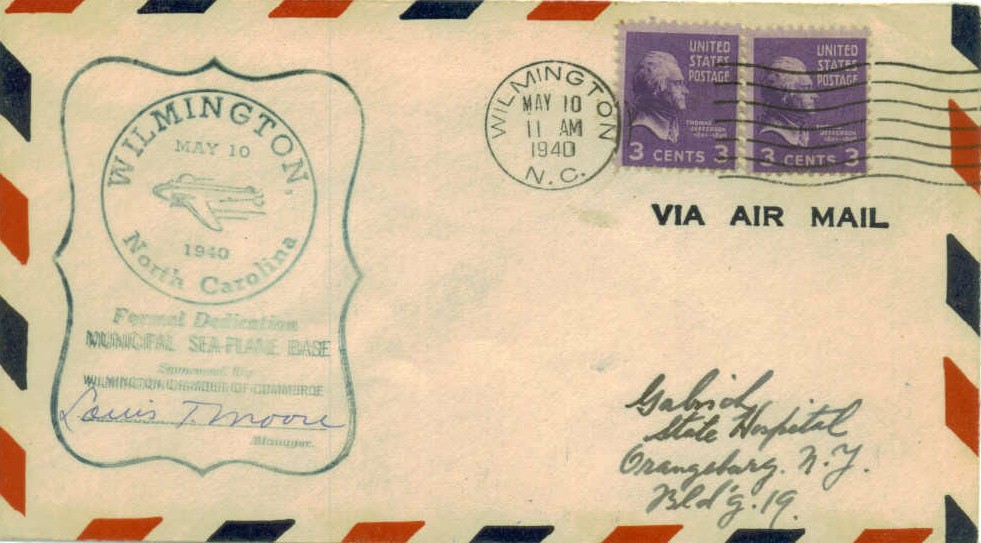
|
807x2 | An airmail cover sent on May 10, 1940 from Wilmington to Orangeburg NY. The cover commemorates the dedication of the opening of the Municipal Seaplane Base in Wilmington. It is signed by Louis Moore, Secretary of the Wilmington Chamber of Commerce.
History: Coastal seaplane bases were established throughout the US to protect its cities with the escalating war situation. Coast Guard patrol aircraft played an important roll in rescuing survivors from damaged vessels. |
RP |
| 1940 |
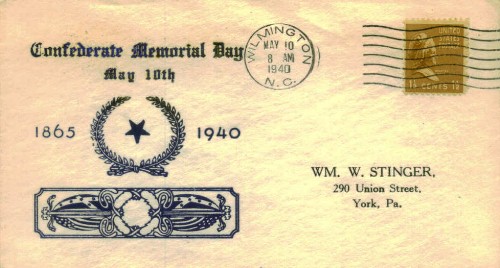
|
805 | A cover sent on May 10, 1940 from Wilmington to York PA. It commemorates Confederate Memorial Day. Another cachet History: Confederate Memorial Day was the day set aside in the South to pay tribute to those who served with the Confederate forces during the Civil War. The Confederate Memorial Day is observed on April 26 in Alabama, Florida, Georgia, and Mississippi; on May 10 in North Carolina and South Carolina; on May 30 in Virginia; and on June 3 in Kentucky, Louisiana, and Tennessee. When General John A. Logan (Commander in Chief of the Grand Army of the Republic - GAR) became impressed with the way the South honored their dead with a special day, he became convinced that such a day must be created to honor Union dead. He became the founder of Decoration Day (a day for the nation to decorate the graves of the war dead with flowers). Decoration Day evolved into a federal holiday, National Memorial Day which was celebrated throughout the US on May 30th. It is believed that date was chosen because flowers would be in bloom all over the country. |
TB |
| 1941 |
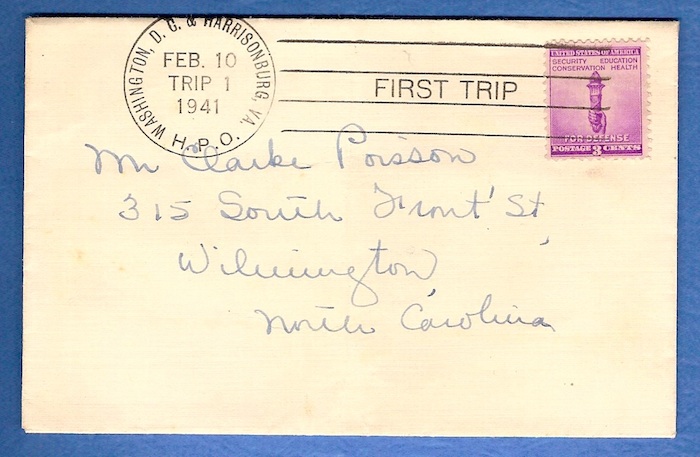
|
901 | A Highway Post Office cover sent on February 10, 1941 from Washington DC to Clark W Poisson in Wilmington NC via Harrisonburg VA. It was canceled enroute on the Highway Post Office first bus - first trip. History: The system of sorting mail while in transit began at the turn of the century with the establishment of the Railway Mail Service. Postal clerks traveling on trains would sort mail en route in order to speed mail delivery. The postal mail canceled on these railroad cars received special RPO (Railway Post Office) postmarks. With declining railroad traffic, buses were used to fill the transportation void. This lead to the creation of the Highway Mail Service. The postal mail canceled on these buses received special HPO (Highway Post Office) postmarks. The first Highway Post Office bus was built by the White Motor Company in Cleveland OH. On February 10, 1941 this bus inaugurated service between Washington DC and Harrisonburg VA, a distance of 149 miles. This bus is now part of the National Postal Museum collection. After the bus was decommissioned in the 1960s, a postal worker hid it in a succession of Post Office Department garages to keep it from being discarded as surplus. It was finally "discovered" and in 1961 sold by the government to members of the United Federation of Postal Clerks. They donated the bus to the Smithsonian Institution and agreed to underwrite the cost of restoring the bus to its proper condition. The bus was subsequently loaned to the Crawford Museum of Transportation and Industry, Western Reserve Historical Society in Cleveland OH. A second bus route was not established until 1946 due to the outbreak of WW-II. Clark W Poisson was married to Beulah Rasberry Poisson who was a long time resident in the Seagate area of Wilmington. She attended Bradley Creek Elementary School and graduated from New Hanover High School. |
RP |
| 1941 |
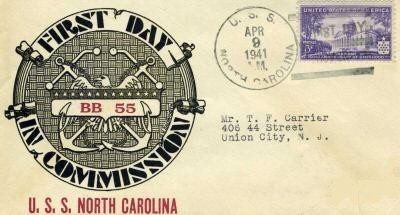
|
903 | A cover canceled on April 9, 1941 commemorating the commissioning of the USS North Carolina. Another cover with a patriotic cachet. History: The USS North Carolina battleship (BB-55) was built in the Brooklyn Navy Yard in New York City. Her keel was laid in October 27, 1937 and she was launched into the East River on June 13, 1940. Armaments were added and she was fitted-out for her mission during late 1940 and early 1941. The USS North Carolina was commissioned on April 9, 1941. When Pearl Harbor was attacked by the Japanese on December 7, 1941, she was undergoing shakedown and training cruises in the Atlantic. She was directed to the Pacific in June 1942 and took part in the Solomons campaign. She covered the initial landings on Guadalcanal and participated in the Battle of the Eastern Solomons in August 1942 when she was damaged by a Japanese submarine torpedo. After being repaired at Pearl Harbor Navy Yard, she returned to the Solomons combat zone toward the end of 1942. In November 1943 she assisted in capturing enemy positions in the Gilbert Islands. This began a pattern of operations for her that lasted for the rest of WW-II. She served in the anti-aircraft screen of aircraft carrier task forces and used her heavy guns to bombard Japanese-held islands. During 1944 she was involved in the Marshalls operation in January-February, attacks on Central Pacific targets through the late winter and spring, the Marianas invasion and Battle of Philippine Sea in June, and Western Pacific carrier strikes in November and December. The USS North Carolina continued her Western Pacific activities in 1945 participating in the invasions of Iwo Jima in February and Okinawa in March and April. She also screened carriers on raids throughout the combat zone including attacks on the Japanese home islands. She was off-Japan in August and September during Japan's surrender. The USS North Carolina returned to the US in October 1945 and operated in the Atlantic until she was inactivated in 1946. She was decommissioned in June 1947 and became part of the "mothball" fleet until stricken from the Navy list in June 1960. On October 2, 1961 she arrived at her current berth in Wilmington NC. Later the next year, on April 25, 1962 the USS North Carolina was officially dedicated as North Carolina's museum and memorial to its WW-II veterans. Visit the USS North Carolina Battleship Memorial. |
RP |
| 1941 |
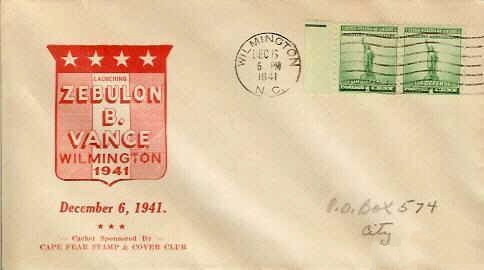
|
899x2 | A cover sent on December 6, 1941 (the day before Pearl Harbor) from Wilmington to Wilmington. The cover commemorates the launching of the "Zebulon B Vance" Liberty Ship, the first ship built at the new Wilmington shipyard. History: Zebulon Baird Vance was known as North Carolina's Civil War Governor. He was born in Buncombe County NC on May 13, 1830 and attended the University at Chapel Hill who granted him a County Court license in Raleigh in late 1851. In1858 Vance won his first congressional seat and was re-elected in 1860. At 28 he was the youngest member of Congress and one of the strongest Southern supporters of the Union. In March 1861 when indications were that the North Carolina legislature was going to vote for secession, Vance resigned his seat and returned to NC. When the ordinance of secession was passed in May 1961, Vance was a captain in Raleigh commanding the company known as the "Rough and Ready Guards." Vance and his men soon became part of the Fourteenth Regiment. Vance was elected colonel of the Twenty-sixth North Carolina Regiment leading his men in the field for thirteen months and distinguishing themselves at New Bern in March 1862 and at Richmond in July 1862. Vance became the "soldier's candidate" for North Carolina governor taking office in September 1862 and was re-elected in 1864. Governor Vance was a Southerner but was a North Carolinian first. With the fall of Fort Fisher in January 1865 followed by Wilmington a few weeks later, the last port open to the Confederacy was closed. Governor Vance was arrested and taken into custody by North's Union troops. He spent time as a prisoner in the Old Capital Prison in the District of Columbia. At the civil war's end in 1865, Vance was paroled and returned to NC. In 1870 Governor Vance won one of the North Carolina seats in the US Senate but still under parole, was not allowed to serve. Then in 1878 Governor Vance was re-elected to the US Senate where he held office until his death on April 14, 1894. In 1941 with the world in conflict with the impending WW-II, Wilmington received government contracts for the crash construction project to create a huge shipyard initially to mass-produce "Liberty Ships." These ships were needed to allow the US to supply its armies and its allies with necessary equipments, supplies and materials. |
RP |
| (> 1859) Page 1 | (1860-1897) Page 2 | (1898-1916) Page 3 | (1917-1941) Page 4 | (1942-1971) Page 5 | (1972 >) Page 6 |